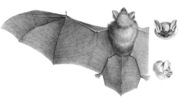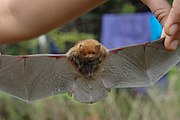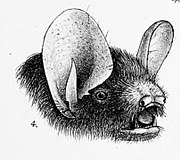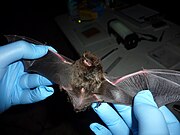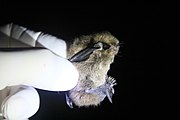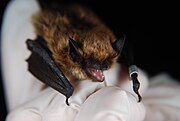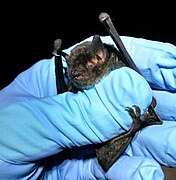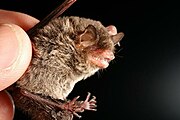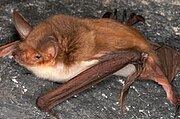Vespertilionids
Subfamily Kerivoulinae
| Common name | Scientific name and subspecies | Range | Size and ecology | IUCN status and estimated population |
|---|---|---|---|---|
| ] | K. dongduongana Tu, Hassanin, Furey, Son, & Csorba, 2018 |
180px|alt=Map of range |
Size: Habitat: Forest and caves Diet: |
LC
|
| ] | K. furva Kuo, Soisook, Ho, Csorba, Wang, & Rossiter, 2017 |
180px|alt=Map of range |
Size: Habitat: Forest and caves Diet: VERIFY POSSIBLE FOOD: Leaves |
LC
|
| Bismarck trumpet-eared bat
|
K. myrella Thomas, 1914 |
Size: Habitat: Forest Diet: |
VU
| |
| Clear-winged woolly bat | K. pellucida (Waterhouse, 1845) |

|
Size: Habitat: Forest Diet: VERIFY POSSIBLE FOOD: Leaves |
NT
|
| Copper woolly bat | K. cuprosa Thomas, 1861 |
Size: Habitat: Forest Diet: |
DD
| |
| Cryptic woolly bat
|
K. crypta Wroughton & Ryley, 1913 |
Size: Habitat: Forest and caves Diet: |
LC
| |
| Damara woolly bat
|
K. argentata Tomes, 1861 Three subspecies
|
Size: Habitat: Savanna Diet: VERIFY POSSIBLE FOOD: Leaves |
LC
| |
| Ethiopian woolly bat
|
K. eriophora (Heuglin, 1877) |
Size: Habitat: Unknown Diet: |
DD
| |
| Flores woolly bat
|
K. flora Thomas, 1914 |
Size: Habitat: Forest Diet: VERIFY POSSIBLE FOOD: Insectivorous |
VU
| |
| Fly River trumpet-eared bat
|
K. muscina Tate, 1941 |
Size: Habitat: Forest Diet: |
LC
| |
| Hardwicke's woolly bat | K. hardwickii (Horsfield, 1824) |
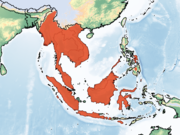
|
Size: Habitat: Forest and caves Diet: VERIFY ME: In highly cluttered places (kruskop 2011) |
LC
|
| Kachin woolly bat
|
K. kachinensis Bates, Struebig, Rossiter, Kingston, Sia Sein Lein Oo, & Khin Mya Mya, 2004 |

|
Size: Habitat: Forest Diet: |
LC
|
| Kerivoula depressa
|
K. depressa Gerrit Smith Miller Jr., 1906 |
Size: Habitat: Forest and caves Diet: VERIFY POSSIBLE FOOD: Leaves |
LC
| |
| Krau woolly bat
|
K. krauensis Francis, Kingston, & Zubaid, 2007 |

|
Size: Habitat: Forest Diet: |
NT
|
| Least woolly bat
|
K. minuta Miller, 1898 |
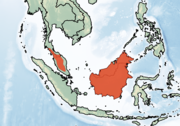
|
Size: Habitat: Forest Diet: |
NT
|
| Lenis woolly bat
|
K. lenis Thomas, 1916 |
Size: Habitat: Forest Diet: |
LC
| |
| Lesser woolly bat | K. lanosa (A. Smith, 1847) Four subspecies
|
Size: UNKNOWN LENGTH SEEN: 40–100 cm (16–39 in) Habitat: Savanna and forest Diet: VERIFY POSSIBLE FOOD: InsectivorousVERIFY POSSIBLE FOOD: Insectivorous |
LC
| |
| Painted bat | K. picta (Pallas, 1767) Two subspecies
|
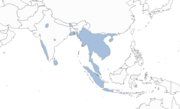
|
Size: VERIFY ME: 3–6 cm (1–2 in) long, plus 3–6 cm (1–2 in) tail Habitat: Forest and grassland Diet: VERIFY ME: Small web spiders (funakoshi et alVERIFY POSSIBLE FOOD: Leaves |
NT
|
| Papillose woolly bat | K. papillosa Temminck, 1840 Two subspecies
|

|
Size: Habitat: Forest Diet: |
LC
|
| Small woolly bat | K. intermedia Hill & Francis, 1984 |
Size: Habitat: Forest Diet: |
NT
| |
| Smith's woolly bat
|
K. smithii Thomas, 1880 |
Size: Habitat: Forest Diet: |
LC
| |
| Spurrell's woolly bat
|
K. phalaena Thomas, 1912 |
Size: Habitat: Forest Diet: |
LC
| |
| St. Aignan's trumpet-eared bat
|
K. agnella Thomas, 1908 |
Size: Habitat: Forest Diet: |
EN
| |
| Tanzanian woolly bat
|
K. africana Dobson, 1878 |
Size: Habitat: Forest Diet: |
EN
| |
| Titania's woolly bat
|
K. titania Bates, Struebig, Hayes, Furey, Mya Mya, Thong, Tien, Son, Harrison, Francis, & Csorba, 2007 |

|
Size: Habitat: Forest Diet: |
LC
|
| Whitehead's woolly bat | K. whiteheadi Thomas, 1894 Three subspecies
|

|
Size: Habitat: Grassland and forest Diet: |
LC
|
| Common name | Scientific name and subspecies | Range | Size and ecology | IUCN status and estimated population |
|---|---|---|---|---|
| Dubious trumpet-eared bat | P. aerosa (Tomes, 1858) |
Size: Habitat: Forest Diet: VERIFY POSSIBLE FOOD: Insectivorous |
DD
| |
| Golden-tipped bat
|
P. papuensis (Dobson, 1878) |

|
Size: Habitat: Forest Diet: VERIFY ME: Spiders from the family araneida (schulz and wainer 1997) which it plucks from webs often on the mid to upper slopes of sclerophyll forests (schulz 2000a, law and chidel 2004) |
VU
|
| Groove-toothed bat
|
P. atrox Miller, 1905 |
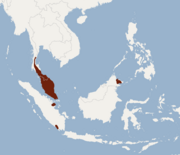
|
Size: Habitat: Forest Diet: |
NT
|
| Peters's trumpet-eared bat
|
P. jagorii (Peters, 1866) |

|
Size: Habitat: Forest and inland wetlands Diet: VERIFY POSSIBLE FOOD: Insectivorous |
LC
|
Subfamily Murininae
| Common name | Scientific name and subspecies | Range | Size and ecology | IUCN status and estimated population |
|---|---|---|---|---|
| Lesser hairy-winged bat | H. harpia Temminck, 1840 Four subspecies
|

|
Size: Habitat: Forest Diet: VERIFY ME: Beetles (bates and harrison 1997) |
LC
|
| Common name | Scientific name and subspecies | Range | Size and ecology | IUCN status and estimated population |
|---|---|---|---|---|
| ] | H. grisea , |
180px|alt=Map of range |
Size: Habitat: Forest Diet: |
DD
|
| Formosan golden tube-nosed bat
|
H. isodon Kuo, Fang, Csorba, & Lee, 2006 |
Size: Habitat: Forest, inland wetlands, and caves Diet: |
LC
|
| Common name | Scientific name and subspecies | Range | Size and ecology | IUCN status and estimated population |
|---|---|---|---|---|
| ] | M. feae Thomas, 1891 |
180px|alt=Map of range |
Size: Habitat: Forest and caves Diet: |
LC
|
| Annam tube-nosed bat
|
M. annamitica Francis & Eger, 2012 |
Size: Habitat: Forest and savanna Diet: |
LC
| |
| Bala tube-nosed bat
|
M. balaensis Soisook, Karapan, Satasook, & Bates, 2013 |

|
Size: Habitat: Forest Diet: VERIFY POSSIBLE FOOD: Insects |
CR
|
| Beelzebub's tube-nosed bat | M. beelzebub Son, Furey, & Csorba, 2011 |
Size: Habitat: Forest Diet: |
DD
| |
| Bicolored tube-nosed bat
|
M. bicolor Kuo, Fang, Csorba, & Lee, 2009 |
Size: Habitat: Forest Diet: |
LC
| |
| Bronze tube-nosed bat
|
M. aenea Hill, 1964 |

|
Size: Habitat: Forest Diet: VERIFY POSSIBLE FOOD: Insectivorous |
VU
|
| Brown tube-nosed bat
|
M. suilla Temminck, 1840 Two subspecies
|

|
Size: UNKNOWN LENGTH SEEN: 3.3–6.0 cm (1–2 in) Habitat: Forest Diet: VERIFY POSSIBLE FOOD: Insects |
LC
|
| Da Lat tube-nosed bat
|
M. harpioloides Kruskop & Eger, 2008 |
Size: Habitat: Forest Diet: |
EN
| |
| Dusky tube-nosed bat
|
M. fusca Sowerby, 1922 |
Size: Habitat: Unknown Diet: |
DD
| |
| Elery's tube-nosed bat
|
M. eleryi Furey, Thong, Bates, & Csorba, 2009 |

|
Size: Habitat: Forest Diet: |
LC
|
| Fiona's tube-nosed bat
|
M. fionae Francis & Eger, 2012 |

|
Size: Habitat: Forest Diet: |
LC
|
| Flute-nosed bat
|
M. florium Thomas, 1908 Three subspecies
|

|
Size: Habitat: Forest and savanna Diet: VERIFY POSSIBLE FOOD: Leaves |
LC
|
| Gilded tube-nosed bat
|
M. rozendaali Hill & Francis, 1984 |

|
Size: Habitat: Forest Diet: VERIFY POSSIBLE FOOD: Insectivorous |
VU
|
| Gloomy tube-nosed bat
|
M. tenebrosa Yoshiyuki, 1970 |
Size: Habitat: Caves and unknown Diet: |
CR
| |
| Golden-haired tube-nosed bat
|
M. chrysochaetes Eger & Lim, 2011 |
Size: Habitat: Forest Diet: VERIFY POSSIBLE FOOD: Insectivorous |
DD
| |
| Greater tube-nosed bat | M. leucogaster (A. Milne-Edwards, 1872) Two subspecies
|
Size: Habitat: Forest Diet: |
LC
| |
| Harrison's tube-nosed bat | M. harrisoni Csorba & Bates, 2005 |

|
Size: Habitat: Forest Diet: |
LC
|
| Hidden tube-nosed bat | M. recondita Kuo, Fang, Csorba, & Lee, 2009 |
Size: Habitat: Forest Diet: VERIFY ME: Insects of the orders coleoptera, lepidoptera and hymenoptera (lu 2013) |
LC
| |
| Hilgendorf's tube-nosed bat | M. hilgendorfi Peters, 1880 |

|
Size: Habitat: Caves and forest Diet: VERIFY ME: In both forested and open areas |
LC
|
| Hutton's tube-nosed bat
|
M. huttoni (Peters, 1872) Two subspecies
|
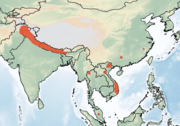
|
Size: Habitat: Forest Diet: VERIFY POSSIBLE FOOD: Leaves |
LC
|
| Jaintia tube-nosed bat
|
M. jaintiana Ruedi, Biswas, & Csorba, 2012 |
Size: Habitat: Forest Diet: |
DD
| |
| Little tube-nosed bat
|
M. aurata A. Milne-Edwards, 1872 |
Size: Habitat: Forest Diet: VERIFY ME: Close to ground (bates and harrison 1997) |
DD
| |
| Lorelie's tube-nosed bat
|
M. lorelieae Eger & Lim, 2011 |
Size: Habitat: Forest Diet: |
DD
| |
| Rainforest tube-nosed bat
|
M. pluvialis Ruedi, Biswas, & Csorba, 2012 |
Size: Habitat: Forest Diet: VERIFY POSSIBLE FOOD: Insectivorous |
DD
| |
| Round-eared tube-nosed bat | M. cyclotis Dobson, 1872 Three subspecies
|

|
Size: UNKNOWN LENGTH SEEN: 80–89 cm (31–35 in) Habitat: Forest and caves Diet: VERIFY POSSIBLE FOOD: InsectsVERIFY POSSIBLE FOOD: Leaves |
LC
|
| Ryukyu tube-nosed bat
|
M. ryukyuana Maeda & Matsumura, 1998 |
Size: Habitat: Forest Diet: |
EN
| |
| Scully's tube-nosed bat
|
M. tubinaris Scully, 1881 |
Size: Habitat: Forest Diet: |
DD
| |
| Shuipu tube-nosed bat
|
M. shuipuensis Eger & Lim, 2011 |
Size: Habitat: Unknown Diet: VERIFY ME: And ecological habit remain unknown |
DD
| |
| Slender tube-nosed bat
|
M. gracilis Kuo, Fang, Csorba, & Lee, 2009 |
Size: Habitat: Forest Diet: |
LC
| |
| Taiwan tube-nosed bat
|
M. puta Kishida, 1924 |
Size: Habitat: Forest Diet: VERIFY POSSIBLE FOOD: Insects |
LC
| |
| Ussuri tube-nosed bat | M. ussuriensis Ogniov, 1913 |

|
Size: Habitat: Forest and caves Diet: VERIFY POSSIBLE FOOD: Leaves |
LC
|
| Walston's tube-nosed bat | M. walstoni Furey, Csorba, & Son, |
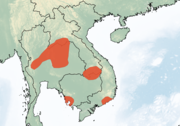
|
Size: Habitat: Forest Diet: |
DD
|
Subfamily Myotinae
| Common name | Scientific name and subspecies | Range | Size and ecology | IUCN status and estimated population |
|---|---|---|---|---|
| Angolan hairy bat
|
C. seabrae Thomas, 1912 |
Size: Habitat: Rocky areas and desert Diet: VERIFY POSSIBLE FOOD: Insects |
LC
| |
| Lesueur's hairy bat
|
C. lesueuri Roberts, 1919 |
Size: Habitat: Shrubland, grassland, and desert Diet: VERIFY POSSIBLE FOOD: Insectivorous |
LC
|
| Common name | Scientific name and subspecies | Range | Size and ecology | IUCN status and estimated population |
|---|---|---|---|---|
| Silver-haired bat | L. noctivagans (Conte, ) |

|
Size: UNKNOWN LENGTH SEEN: 5–9 cm (2–4 in) Habitat: Forest, rocky areas, and caves Diet: VERIFY ME: Larvae on trees (kunz 1982)VERIFY ME: Normally |
LC
|
| Common name | Scientific name and subspecies | Range | Size and ecology | IUCN status and estimated population |
|---|---|---|---|---|
| Alcathoe bat | M. alcathoe von Helversen & Heller, 2001 |

|
Size: Habitat: Forest Diet: |
DD
|
| Anjouan myotis
|
M. anjouanensis Dorst, 1960 |
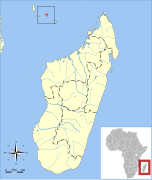
|
Size: Habitat: Unknown Diet: |
DD
|
| Annamit myotis
|
M. annamiticus Kruskop and Tsytsulina, 2001 |

|
Size: Habitat: Forest and inland wetlands Diet: VERIFY POSSIBLE FOOD: Insects |
DD
|
| Arizona myotis
|
M. occultus Hollister, 1909 |
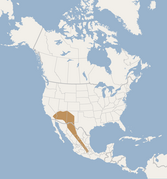
|
Size: UNKNOWN LENGTH SEEN: 24–25 cm (9–10 in) Habitat: Forest, rocky areas, caves, and desert Diet: VERIFY ME: Determined by prey availability |
LC
|
| Atacama myotis
|
M. atacamensis Lataste, 1892 |
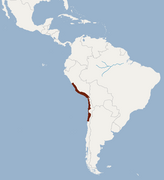
|
Size: Habitat: Shrubland, rocky areas, and desert Diet: VERIFY POSSIBLE FOOD: Insectivorous |
EN
|
| Australian myotis
|
M. australis Dobson, 1878 |

|
Size: Habitat: Unknown Diet: |
DD
|
| Australian myotis
|
M. australis Dobson, 1878 |

|
Size: Habitat: Unknown Diet: |
DD
|
| Barbados myotis
|
M. nyctor LaVal & Schwartz, 1974 |
Size: Habitat: Forest and caves Diet: VERIFY POSSIBLE FOOD: Insectivorous |
VU
| |
| Bechstein's bat | M. bechsteinii (Kuhl, 1817) |

|
Size: Habitat: Forest, shrubland, and caves Diet: VERIFY POSSIBLE FOOD: Insects |
NT
|
| Beijing mouse-eared bat
|
M. pequinius Thomas, 1908 |
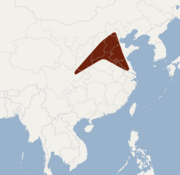
|
Size: Habitat: Forest and caves Diet: |
LC
|
| Black myotis | M. nigricans Schinz, 1821 Four subspecies
|

|
Size: Habitat: Forest, savanna, shrubland, and caves Diet: VERIFY POSSIBLE FOOD: Insectivorous |
LC
|
| Bocharic myotis
|
M. bucharensis Kuzyakin, 1950 |

|
Size: Habitat: Caves Diet: |
DD
|
| Bornean whiskered myotis
|
M. borneoensis Hill and Francis, 1984 |

|
Size: Habitat: Forest Diet: |
DD
|
| Brandt's bat | M. brandtii (Eversmann, 1845) Two subspecies
|

|
Size: Habitat: Forest, shrubland, grassland, inland wetlands, and caves Diet: |
LC
|
| Burmese whiskered myotis | M. montivagus (Dobson, 1874) Four subspecies
|

|
Size: Habitat: Forest and caves Diet: VERIFY POSSIBLE FOOD: Insectivores |
DD
|
| California myotis | M. californicus (Audubon & Bachman, 1842) Four subspecies
|
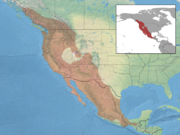
|
Size: UNKNOWN LENGTH SEEN: 70–94 cm (28–37 in) Habitat: Forest, caves, and desert Diet: VERIFY ME: Only on insects in flight and are slow, acrobatic flyers, detecting prey at close range (less than 1 meter) and using echolocation calls during approachVERIFY POSSIBLE FOOD: Insects |
LC
|
| Cape hairy bat
|
M. tricolor (Temminck, 1832) |

|
Size: Habitat: Forest, savanna, and shrubland Diet: |
LC
|
| Cave myotis | M. velifer (Allen, 1890) Five subspecies
|

|
Size: UNKNOWN LENGTH SEEN: 30–40 cm (12–16 in) Habitat: Forest and caves Diet: VERIFY POSSIBLE FOOD: InsectsVERIFY ME: For insects during the night hours, and have been seen gathering at pools of water in order to drink |
LC
|
| Chilean myotis | M. chiloensis (Waterhouse, 1840) |

|
Size: Habitat: Rocky areas and forest Diet: |
LC
|
| Chinese water myotis
|
M. laniger Peters, 1870 |

|
Size: Habitat: Forest and caves Diet: |
LC
|
| Cinnamon myotis
|
M. fortidens Miller & Allen, 1928 Two subspecies
|

|
Size: Habitat: Forest and caves Diet: VERIFY POSSIBLE FOOD: Insectivorous |
LC
|
| Cryptic myotis | M. crypticus Ruedi, Ibáñez, Salicini, Juste, & Puechmaille, 2019 |
Size: Habitat: Forest, inland wetlands, and caves Diet: VERIFY ME: A broad range of arthropods, especially lepidoptera, diptera and araneae, and much of its prey is not volant at night and is therefore likely taken by gleaning |
NT
| |
| Csorba's mouse-eared bat
|
M. csorbai Topál, 1997 |
Size: Habitat: Forest Diet: |
DD
| |
| Curacao myotis
|
M. nesopolus Miller, 1900 Two subspecies
|

|
Size: Habitat: Forest and shrubland Diet: VERIFY POSSIBLE FOOD: Insects |
LC
|
| Dark-nosed small-footed myotis
|
M. melanorhinus Merriam, 1890 |

|
Size: Habitat: Caves and forest Diet: VERIFY ME: A variety of small flying insects |
LC
|
| Daubenton's bat | M. daubentonii (Kuhl, 1817) Seven subspecies
|

|
Size: UNKNOWN LENGTH SEEN: 0–10 cm (0–4 in) Habitat: Forest, shrubland, inland wetlands, rocky areas, caves, and neritic marine Diet: VERIFY ME: Closer to their roost than malesVERIFY ME: Site was 800 m |
LC
|
| David's myotis
|
M. davidii Peters, 1869 |

|
Size: Habitat: Caves and forest Diet: VERIFY ME: In forest |
LC
|
| Dinelli's myotis | M. dinellii Thomas, 1902 |

|
Size: Habitat: Forest Diet: |
LC
|
| Dominican myotis
|
M. dominicensis Miller, 1902 |
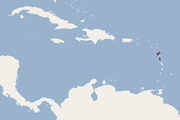
|
Size: Habitat: Inland wetlands and caves Diet: VERIFY POSSIBLE FOOD: Insectivorous |
VU
|
| Eastern long-fingered bat | M. macrodactylus (Temminck, 1840) Three subspecies
|

|
Size: Habitat: Forest, inland wetlands, and caves Diet: VERIFY POSSIBLE FOOD: Insects |
LC
|
| Eastern small-footed myotis | M. leibii Audubon & Bachman, 1842 |

|
Size: UNKNOWN LENGTH SEEN: 75–85 cm (30–33 in) Habitat: Caves, rocky areas, and forest Diet: VERIFY POSSIBLE FOOD: Insectivores |
EN
|
| Eastern water bat
|
M. petax Hollister, 1912 |
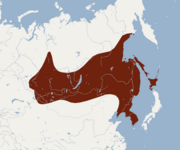
|
Size: Habitat: Caves, inland wetlands, and forest Diet: VERIFY ME: Small insects |
LC
|
| Elegant myotis
|
M. elegans Hall, 1962 |

|
Size: Habitat: Forest Diet: |
LC
|
| Escalera's bat | M. escalerai A. Cabrera, 1904 |
Size: Habitat: Forest, shrubland, and caves Diet: VERIFY ME: A broad range of arthropods, especially lepidoptera, diptera and araneae, and much of its prey is not volant at night and is therefore likely taken by gleaning |
NT
| |
| Far Eastern myotis
|
M. bombinus Thomas, 1906 Two subspecies
|

|
Size: Habitat: Forest and caves Diet: |
NT
|
| Felten's myotis | M. punicus Felten, 1977 |

|
Size: Habitat: Caves, grassland, shrubland, and forest Diet: |
DD
|
| Findley's myotis
|
M. findleyi Bogan, 1978 |

|
Size: Habitat: Unknown Diet: VERIFY POSSIBLE FOOD: Insects |
EN
|
| Flat-headed myotis
|
M. planiceps Baker, 1955 |
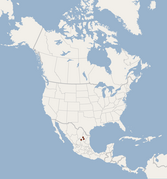
|
Size: Habitat: Forest and caves Diet: VERIFY POSSIBLE FOOD: Insectivorous |
EN
|
| Fraternal myotis | M. frater (Allen, 1923) Four subspecies
|

|
Size: Habitat: Forest and caves Diet: |
LC
|
| Fringed long-footed myotis
|
M. fimbriatus Peters, 1870 |
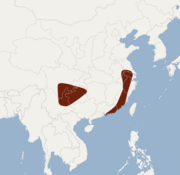
|
Size: Habitat: Caves Diet: |
LC
|
| Fringed myotis | M. thysanodes Miller, 1897 Four subspecies
|
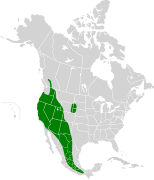
|
Size: UNKNOWN LENGTH SEEN: 50–60 cm (20–24 in) Habitat: Forest, rocky areas, caves, and desert Diet: VERIFY ME: Close to the vegetative canopy, and have relatively slow and highly maneuverable flightVERIFY ME: Close to the vegetative canopy |
LC
|
| Frosted myotis
|
M. pruinosus Yoshiyuki, 1971 |

|
Size: Habitat: Forest and caves Diet: |
EN
|
| Geoffroy's bat | M. emarginatus (Geoffroy, 1806) Three subspecies
|

|
Size: UNKNOWN LENGTH SEEN: 9–11.5 cm (4–5 in) Habitat: Caves, grassland, and shrubland Diet: VERIFY ME: Over farmlands, shrub lands, and forested areas, sometimes near areas of water |
LC
|
| Gomantong myotis
|
M. gomantongensis Francis & Hill, 1998 |
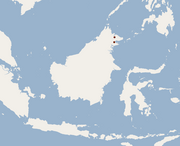
|
Size: Habitat: Caves Diet: VERIFY POSSIBLE FOOD: Insectivorous |
LC
|
| Gray bat | M. grisescens Howell, 1909 |
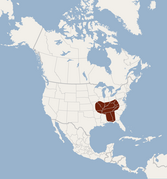
|
Size: UNKNOWN LENGTH SEEN: 6–11 cm (2–4 in) Habitat: Forest and caves Diet: VERIFY ME: (tuttle 1979)VERIFY ME: On insects, usually flying above a river, stream, or reservoir |
VU
|
| Greater mouse-eared bat | M. myotis (Borkhausen, 1797) Two subspecies
|

|
Size: UNKNOWN LENGTH SEEN: 6.5–8.0 cm (3–3 in) Habitat: Forest, shrubland, and caves Diet: VERIFY ME: These invertebratesVERIFY ME: Ground beetles such as carabids (carabidae), but also prey on large moths and grass beetles whenever possible |
LC
|
| Guatemalan myotis
|
M. cobanensis Goodwin, 1955 |

|
Size: Habitat: Diet: |
DD
|
| Hairy-faced bat
|
M. annectans Dobson, 1871 |

|
Size: Habitat: Forest Diet: |
LC
|
| Hairy-legged myotis | M. keaysi Allen, 1914 Two subspecies
|

|
Size: Habitat: Forest Diet: VERIFY POSSIBLE FOOD: Insectivorous |
LC
|
| Herman's myotis
|
M. hermani Thomas, 1923 |

|
Size: Habitat: Forest Diet: |
DD
|
| Himalayan whiskered bat
|
M. siligorensis Horsfield, 1855 Four subspecies
|

|
Size: Habitat: Forest and caves Diet: VERIFY ME: In scattered secondary growth deciduous trees at the height of 2 to 5 meters and are some meters away from vegetation (surlykke et al |
LC
|
| Hodgson's bat | M. formosus (Hodgson, 1835) Seven subspecies
|

|
Size: Habitat: Forest, shrubland, grassland, and caves Diet: VERIFY POSSIBLE FOOD: Insects |
NT
|
| Horsfield's bat | M. horsfieldii Temminck, 1840 Five subspecies
|

|
Size: Habitat: Forest and caves Diet: |
LC
|
| Ikonnikov's bat
|
M. ikonnikovi Ogniov, 1912 |

|
Size: Habitat: Forest, inland wetlands, and caves Diet: VERIFY ME: Flying insects low above ground and forest rivers |
LC
|
| Indiana bat | M. sodalis Miller, 1898 |

|
Size: UNKNOWN LENGTH SEEN: 3.0–7.2 cm (1–3 in) Habitat: Forest and caves Diet: VERIFY POSSIBLE FOOD: Insectivorous |
NT
|
| Insular myotis
|
M. insularum Dobson, 1878 |
Size: Habitat: Unknown Diet: |
DD
| |
| Kashmir cave bat
|
M. longipes Dobson, 1873 |
Size: Habitat: Forest and caves Diet: |
DD
| |
| Keen's myotis | M. keenii (Merriam, 1895) |
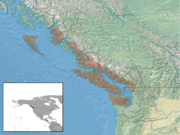
|
Size: UNKNOWN LENGTH SEEN: 13–20 cm (5–8 in) Habitat: Forest and rocky areas Diet: VERIFY ME: Their own |
LC
|
| Kei myotis
|
M. stalkeri Thomas, 1910 |

|
Size: Habitat: Forest, inland wetlands, and caves Diet: VERIFY ME: Over freshwater, and it is possible that it also forages above the sea |
LC
|
| Kock's mouse-eared bat
|
M. dieteri Happold, 2005 |
Size: Habitat: Forest and caves Diet: |
DD
| |
| Large myotis
|
M. chinensis Tomes, 1857 |

|
Size: Habitat: Forest, inland wetlands, and caves Diet: |
LC
|
| Large-footed bat | M. adversus Horsfield, 1824 Six subspecies
|

|
Size: Habitat: Forest, inland wetlands, and caves Diet: |
LC
|
| Lesser large-footed bat
|
M. hasseltii Temminck, 1840 Four subspecies
|

|
Size: Habitat: Forest and caves Diet: VERIFY ME: Small insects like the mosquitoes, gnats, flies and moths (bates and harrison 1997) |
LC
|
| Lesser mouse-eared bat | M. blythii Tomes, 1857 Four subspecies
|

|
Size: Habitat: Shrubland, grassland, and caves Diet: |
LC
|
| Little brown bat | M. lucifugus (Conte, 1831) Five subspecies
|
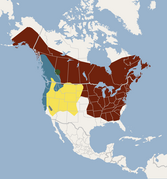
|
Size: VERIFY ME: long, plus 2–7 cm (1–3 in) tail Habitat: Forest and caves Diet: VERIFY ME: Mosquitoes tooVERIFY ME: Insects along with the mother's milk |
EN
|
| Long-eared myotis | M. evotis (H. Allen, 1864) Six subspecies
|

|
Size: UNKNOWN LENGTH SEEN: 19–22 cm (7–9 in) Habitat: Caves, rocky areas, and forest Diet: VERIFY POSSIBLE FOOD: InsectivorousVERIFY POSSIBLE FOOD: Insects |
LC
|
| Long-fingered bat | M. capaccinii Bonaparte, 1837 |

|
Size: Habitat: Shrubland, inland wetlands, and caves Diet: |
VU
|
| Long-legged myotis | M. volans H. Allen, 1866 Four subspecies
|
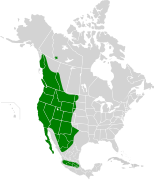
|
Size: UNKNOWN LENGTH SEEN: 7–7.6 cm (3–3 in) Habitat: Forest, rocky areas, caves, and desert Diet: VERIFY ME: Other, mostly soft-bodied, insects such as flies, termites, lacewings, wasps, true bugs, leaf-hoppers, and small beetles (warner and czaplewski 1984)VERIFY POSSIBLE FOOD: Insects |
LC
|
| Long-tailed myotis
|
M. longicaudatus Ogniov, 1927 |

|
Size: Habitat: Forest, inland wetlands, and caves Diet: |
LC
|
| Long-toed myotis | M. secundus Ruedi, Csorba, Lin, & Chou, 2015 |
Size: Habitat: Forest Diet: VERIFY ME: Small insects (cheng, fang and chou 2015) |
LC
| |
| Malagasy mouse-eared bat
|
M. goudoti Smith, 1834 |

|
Size: Habitat: Forest, rocky areas, and caves Diet: VERIFY ME: (randrianandriananina et al |
LC
|
| Malaysian whiskered myotis
|
M. federatus Thomas, 1916 |

|
Size: Habitat: Forest Diet: |
DD
|
| Maluku myotis
|
M. moluccarum Thomas, 1915 Three subspecies
|

|
Size: Habitat: Forest and inland wetlands Diet: VERIFY ME: Large aquatic insects and small fish |
LC
|
| Mandelli's mouse-eared bat
|
M. sicarius Thomas, 1915 |
Size: Habitat: Forest and caves Diet: |
VU
| |
| Montane myotis
|
M. oxyotus Peters, 1867 Two subspecies
|

|
Size: Habitat: Forest Diet: |
LC
|
| Morris's bat
|
M. morrisi Hill, 1971 |

|
Size: Habitat: Savanna and caves Diet: |
DD
|
| Myotis annatessae
|
M. annatessae Kruskop & Borisenko, 2013 |
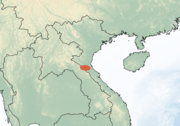
|
Size: Habitat: Forest Diet: |
DD
|
| Myotis diminutus
|
M. diminutus Moratelli & Wilson, 2011 |
Size: Habitat: Forest Diet: VERIFY POSSIBLE FOOD: Insectivorous |
DD
| |
| Myotis indochinensis
|
M. indochinensis Son, Motokawa, Estók, Thong, Dang, Oshida, Csorba, Francis, Görföl, & Endō, 2013 |
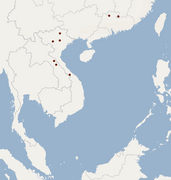
|
Size: Habitat: Forest Diet: VERIFY ME: And also roost in forests, logging may also threaten its populations |
DD
|
| Myotis izecksohni
|
M. izecksohni Moratelli, Peracchi, Dias, & de Oliveira, 2011 |
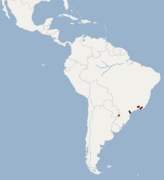
|
Size: Habitat: Forest Diet: |
DD
|
| Myotis lavali
|
M. lavali Moratelli, Peracchi, Dias, & de Oliveira, 2011 |
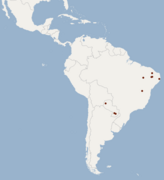
|
Size: Habitat: Forest, savanna, and grassland Diet: |
LC
|
| Myotis macropus | M. macropus (Gould, 1854) |
Size: Habitat: Inland wetlands and caves Diet: VERIFY POSSIBLE FOOD: Insects |
LC
| |
| Myotis septentrionalis | M. septentrionalis Trouessart, 1897 |

|
Size: UNKNOWN LENGTH SEEN: 17–19 cm (7–7 in) Habitat: Forest and caves Diet: VERIFY ME: Lepidoptera, coleoptera, neuroptera, diprea, hemiptera, homoptera, and hymenoptera; the diet varies between localities and seasonsVERIFY POSSIBLE FOOD: Insects |
NT
|
| Myotis vivesi | M. vivesi Ménégaux, 1901 |

|
Size: UNKNOWN LENGTH SEEN: 55–65 cm (22–26 in) Habitat: Rocky areas and caves Diet: VERIFY ME: Over water in these areas |
VU
|
| Natterer's bat | M. nattereri (Kuhl, 1817) Two subspecies
|
Size: Habitat: Forest, shrubland, grassland, inland wetlands, and caves Diet: |
LC
| |
| Nepal myotis
|
M. nipalensis Dobson, 1871 Three subspecies
|

|
Size: Habitat: Forest, shrubland, grassland, caves, and desert Diet: VERIFY POSSIBLE FOOD: Insects |
LC
|
| Nimba myotis
|
M. nimbaensis Simmons, Flanders, Fils, Parker, Suter, Bamba, Douno, Keita, Morales, & Frick, 2021 |
Size: Habitat: Forest, grassland, inland wetlands, caves, and shrubland Diet: VERIFY POSSIBLE FOOD: Insectivorous |
CR
| |
| Orange-fingered myotis
|
M. rufopictus (Waterhouse, 1845) |
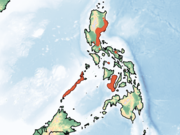
|
Size: Habitat: Forest Diet: |
DD
|
| Pallid large-footed myotis
|
M. macrotarsus Waterhouse, 1845 Two subspecies
|

|
Size: Habitat: Caves Diet: |
LC
|
| Peninsular myotis | M. peninsularis Miller, 1898 |

|
Size: Habitat: Forest and caves Diet: |
EN
|
| Peters's myotis
|
M. ater (Peters, 1866) Two subspecies
|

|
Size: Habitat: Forest Diet: VERIFY POSSIBLE FOOD: Insectivorous |
LC
|
| Peyton's myotis
|
M. peytoni Wroughton & Ryley, 1913 |

|
Size: Habitat: Forest Diet: |
DD
|
| Pond bat | M. dasycneme (Boie, 1825) |

|
Size: Habitat: Forest, inland wetlands, and caves Diet: VERIFY POSSIBLE FOOD: Insects |
NT
|
| Red myotis | M. ruber Geoffroy, 1806 |

|
Size: Habitat: Forest Diet: |
NT
|
| Reddish myotis
|
M. soror Ruedi, Csorba, Lin, & Chou, 2015 |
Size: Habitat: Forest Diet: VERIFY POSSIBLE FOOD: Insectivorous |
DD
| |
| Reddish-black myotis | M. rufoniger (Tomes, 1858) |

|
Size: Habitat: Forest and caves Diet: VERIFY ME: And also roost in forests, logging may also threaten its populations |
LC
|
| Rickett's big-footed bat
|
M. pilosus Peters, 1869 |

|
Size: Habitat: Forest and inland wetlands Diet: VERIFY ME: Comprised of fish |
VU
|
| Ridley's bat
|
M. ridleyi Thomas, 1898 |

|
Size: Habitat: Caves, inland wetlands, and forest Diet: VERIFY ME: Over small streams in forest, and so perhaps it is water dependent |
NT
|
| Riparian myotis
|
M. riparius Handley, 1960 |
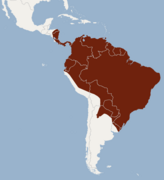
|
Size: Habitat: Forest Diet: VERIFY POSSIBLE FOOD: Insectivorous |
LC
|
| Rufous mouse-eared bat | M. bocagii Peters, 1870 Three subspecies
|

|
Size: Habitat: Forest and savanna Diet: VERIFY POSSIBLE FOOD: Leaves |
LC
|
| Schaub's myotis
|
M. schaubi Kormos, 1934 Two subspecies
|
Size: Habitat: Forest, shrubland, and caves Diet: |
DD
| |
| Schwartz's myotis
|
M. martiniquensis LaVal, 1973 Two subspecies
|

|
Size: Habitat: Caves Diet: VERIFY POSSIBLE FOOD: Insectivorous |
NT
|
| Scott's mouse-eared bat
|
M. scotti Thomas, 1927 |
Size: Habitat: Forest and shrubland Diet: |
VU
| |
| Siberian bat
|
M. sibiricus (Kastschenko, 1905) |

|
Size: Habitat: Forest, savanna, rocky areas, and caves Diet: |
LC
|
| Silver-tipped myotis | M. albescens Geoffroy, 1806 |

|
Size: Habitat: Forest Diet: VERIFY POSSIBLE FOOD: Insectivorous |
LC
|
| Singapore whiskered bat
|
M. oreias (Temminck, 1840) |

|
Size: Habitat: Unknown Diet: |
DD
|
| Southeastern myotis | M. austroriparius (Rhoads, 1897) |

|
Size: VERIFY ME: long, plus 2–5 cm (1–2 in) tail Habitat: Forest and caves Diet: VERIFY ME: Primarily over lakes, ponds, or slow-moving streamsVERIFY ME: Ovr water when feeding at night |
LC
|
| Southern myotis
|
M. aelleni Baud, 1979 |

|
Size: Habitat: Unknown Diet: |
DD
|
| Southwestern myotis | M. auriculus Baker & Stains, 1955 Two subspecies
|

|
Size: UNKNOWN LENGTH SEEN: 12–18 cm (5–7 in) Habitat: Forest, caves, and desert Diet: VERIFY POSSIBLE FOOD: Insectivorous |
LC
|
| Szechwan myotis
|
M. altarium Thomas, 1911 |

|
Size: Habitat: Caves Diet: |
LC
|
| Thick-thumbed myotis
|
M. rosseti Oey, 1951 |

|
Size: Habitat: Forest Diet: |
LC
|
| Velvety myotis
|
M. simus Thomas, 1901 |

|
Size: Habitat: Forest Diet: |
DD
|
| Wall-roosting mouse-eared bat | M. muricola (Gray, 1846) Seven subspecies
|

|
Size: Habitat: Forest and caves Diet: VERIFY POSSIBLE FOOD: Leaves |
LC
|
| Weber's myotis
|
M. weberi (Jentink, 1890) |
Size: Habitat: Forest Diet: |
DD
| |
| Welwitsch's bat | M. welwitschii (Gray, 1866) |

|
Size: Habitat: Forest, savanna, shrubland, and grassland Diet: VERIFY POSSIBLE FOOD: Leaves |
LC
|
| Western small-footed bat | M. ciliolabrum (Merriam, 1842) |

|
Size: UNKNOWN LENGTH SEEN: 205–245 cm (81–96 in) Habitat: Forest, rocky areas, caves, and desert Diet: VERIFY ME: Trichoptera as well (holloway and barclay 2001)VERIFY ME: Within 1km of waterbodies |
LC
|
| Whiskered bat | M. mystacinus (Kuhl, 1817) Three subspecies
|

|
Size: UNKNOWN LENGTH SEEN: 35–48 cm (14–19 in) Habitat: Desert, caves, grassland, shrubland, and forest Diet: VERIFY ME: Non-aquatic flying insects, such as mosquitoesVERIFY ME: During the night |
LC
|
| Yanbaru whiskered bat
|
M. yanbarensis Maeda & Matsumura, 1998 |
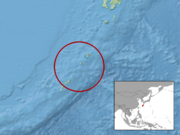
|
Size: Habitat: Forest Diet: |
CR
|
| Yellowish myotis | M. levis Geoffroy, 1806 Two subspecies
|

|
Size: Habitat: Forest Diet: |
LC
|
| Yuma myotis | M. yumanensis H. Allen, 1864 Six subspecies
|

|
Size: VERIFY ME: 8–10 cm (3–4 in) long, plus 3–5 cm (1–2 in) tail Habitat: Forest and caves Diet: VERIFY POSSIBLE FOOD: InsectsVERIFY POSSIBLE FOOD: Insects |
LC
|
References
- ^ Srinivasulu, B.; Srinivasulu, C. (2019). "Falsistrellus affinis". IUCN Red List of Threatened Species. 2019: e.T17324A22131594. doi:10.2305/IUCN.UK.2019-3.RLTS.T17324A22131594.en. Cite error: The named reference "IUCN" was defined multiple times with different content (see the help page).
- ^ Aplin, K.; Armstrong, K. N. (2021). "Kerivoula myrella". IUCN Red List of Threatened Species. 2021: e.T10980A22022572. doi:10.2305/IUCN.UK.2021-1.RLTS.T10980A22022572.en.
- ^ Nor Zalipah, M. (2020). "Kerivoula pellucida". IUCN Red List of Threatened Species. 2020: e.T10983A22021330. doi:10.2305/IUCN.UK.2020-2.RLTS.T10983A22021330.en.
- ^ Fahr. J. (2019). "Kerivoula cuprosa". IUCN Red List of Threatened Species. 2019: e.T10971A21971772. doi:10.2305/IUCN.UK.2019-3.RLTS.T10971A21971772.en.
- ^ Tu, V.; Furey, N.; Csorba, G. (2021). "Kerivoula crypta". IUCN Red List of Threatened Species. 2021: e.T154196297A154196362. doi:10.2305/IUCN.UK.2021-2.RLTS.T154196297A154196362.en.
- ^ Monadjem, A.; Taylor, P. J.; Jacobs, D.; Cotterill, F. (2017). "Kerivoula argentata". IUCN Red List of Threatened Species. 2017: e.T10969A21970780. doi:10.2305/IUCN.UK.2017-2.RLTS.T10969A21970780.en.
- ^ Fahr. J. (2019). "Kerivoula eriophora". IUCN Red List of Threatened Species. 2019: e.T10972A21971992. doi:10.2305/IUCN.UK.2019-3.RLTS.T10972A21971992.en.
- ^ Waldien, D. L.; Wiantoro, S. (2021). "Kerivoula flora". IUCN Red List of Threatened Species. 2021: e.T10973A21972598. doi:10.2305/IUCN.UK.2021-2.RLTS.T10973A21972598.en.
- ^ Aplin, K.; Armstrong, K. N. (2021) . "Kerivoula muscina". IUCN Red List of Threatened Species. 2021: e.T10979A209536068. doi:10.2305/IUCN.UK.2021-3.RLTS.T10979A209536068.en.
- ^ Tu, V.; Furey, N.; Görföl, T.; Csorba, G. (2020). "Kerivoula hardwickii". IUCN Red List of Threatened Species. 2020: e.T154195594A21973742. doi:10.2305/IUCN.UK.2020-2.RLTS.T154195594A21973742.en.
- ^ Bates, P. J. J.; Thong, V. D.; Soisook, P. (2019). "Kerivoula kachinensis". IUCN Red List of Threatened Species. 2019: e.T136240A22001145. doi:10.2305/IUCN.UK.2019-3.RLTS.T136240A22001145.en.
- ^ Tu, V.; Furey, N.; Csorba, G. (2021). "Kerivoula depressa". IUCN Red List of Threatened Species. 2021: e.T154195907A154195912. doi:10.2305/IUCN.UK.2021-2.RLTS.T154195907A154195912.en.
- ^ Nor Zalipah, M. (2020). "Kerivoula krauensis". IUCN Red List of Threatened Species. 2020: e.T136572A21992300. doi:10.2305/IUCN.UK.2020-2.RLTS.T136572A21992300.en.
- ^ Nor Zalipah, M. (2020). "Kerivoula minuta". IUCN Red List of Threatened Species. 2020: e.T10978A22022086. doi:10.2305/IUCN.UK.2020-2.RLTS.T10978A22022086.en.
- ^ Srinivasulu, C.; Srinivasulu, B. (2019). "Kerivoula lenis". IUCN Red List of Threatened Species. 2019: e.T136428A21984385. doi:10.2305/IUCN.UK.2019-3.RLTS.T136428A21984385.en.
- ^ Cite error: The named reference
ADWLesserwoollybatwas invoked but never defined (see the help page). - ^ Monadjem, A.; Taylor, P. J.; Jacobs, D.; Cotterill, F. (2017). "Kerivoula lanosa". IUCN Red List of Threatened Species. 2017: e.T10977A22021700. doi:10.2305/IUCN.UK.2017-2.RLTS.T10977A22021700.en.
- ^ Cite error: The named reference
ADWPaintedbatwas invoked but never defined (see the help page). - ^ Huang, J. C. -C.; Lim, L. S.; Chakravarty, R. (2020). "Kerivoula picta". IUCN Red List of Threatened Species. 2020: e.T10985A22022952. doi:10.2305/IUCN.UK.2020-2.RLTS.T10985A22022952.en.
- ^ Hutson, A. M.; Kingston, T. (2021). "Kerivoula papillosa". IUCN Red List of Threatened Species. 2021: e.T10981A22020906. doi:10.2305/IUCN.UK.2021-1.RLTS.T10981A22020906.en.
- ^ Nor Zalipah, M. (2020). "Kerivoula intermedia". IUCN Red List of Threatened Species. 2020: e.T10975A21974054. doi:10.2305/IUCN.UK.2020-2.RLTS.T10975A21974054.en.
- ^ Monadjem, A.; Fahr, J. (2017). "Kerivoula smithii". IUCN Red List of Threatened Species. 2017: e.T10986A22023189. doi:10.2305/IUCN.UK.2017-2.RLTS.T10986A22023189.en.
- ^ Monadjem, A.; Fahr, J. (2017). "Kerivoula phalaena". IUCN Red List of Threatened Species. 2017: e.T10984A22021608. doi:10.2305/IUCN.UK.2017-2.RLTS.T10984A22021608.en.
- ^ Aplin, K.; Armstrong, K. N. (2021) . "Kerivoula agnella". IUCN Red List of Threatened Species. 2021: e.T10968A209548421. doi:10.2305/IUCN.UK.2021-3.RLTS.T10968A209548421.en.
- ^ Cooper-Bohannon, R.; Fahr, J.; Jacobs, D. (2020). "Kerivoula africana". IUCN Red List of Threatened Species. 2020: e.T10966A21975149. doi:10.2305/IUCN.UK.2020-2.RLTS.T10966A21975149.en.
- ^ Bates, P. J. J.; Soisook, P.; Thong, V. D. (2019). "Kerivoula titania". IUCN Red List of Threatened Species. 2019: e.T136817A22044302. doi:10.2305/IUCN.UK.2019-3.RLTS.T136817A22044302.en.
- ^ Duya, M. R.; Alvarez, J.; Fidelino, J.; Gatan-Balbas, M.; Pedregosa, M.; Veluz, M. J.; Jakosalem, P. G.; Tanalgo, K.; Mendoza, R. V.; Cielo, K. L. S.; Garcia, J. J. L.; Cacho, M. A.; Dionisio, T. (2019). "Kerivoula whiteheadi". IUCN Red List of Threatened Species. 2019: e.T10987A22023276. doi:10.2305/IUCN.UK.2019-3.RLTS.T10987A22023276.en.
- ^ Francis, C. M.; Csorba, G.; Monadjem, A.; Waldien, D. L. (2022). "Phoniscus aerosus". IUCN Red List of Threatened Species. 2022: e.T10967A21975373. doi:10.2305/IUCN.UK.2022-2.RLTS.T10967A21975373.en.
- ^ Loyd, A. M.; Pennay, M. (2021). "Phoniscus papuensis". IUCN Red List of Threatened Species. 2021: e.T10982A22021190. doi:10.2305/IUCN.UK.2021-1.RLTS.T10982A22021190.en.
- ^ Jayaraj, V. K. (2020). "Phoniscus atrox". IUCN Red List of Threatened Species. 2020: e.T10970A21970973. doi:10.2305/IUCN.UK.2020-2.RLTS.T10970A21970973.en.
- ^ Oo, S. S. L.; Kingston, T.; Francis, C.; Rosell-Ambal, R. G. B.; Tabaranza, B. (2019). "Phoniscus jagorii". IUCN Red List of Threatened Species. 2019: e.T10976A21974660. doi:10.2305/IUCN.UK.2019-3.RLTS.T10976A21974660.en.
- ^ Csorba, G.; Bumrungsri, S.; Francis, C.; Bates, P.; Rosell-Ambal, R. G. B.; Tabaranza, B.; Heaney, L.; Molur, S.; Srinivasulu, C. (2019). "Harpiocephalus harpia". IUCN Red List of Threatened Species. 2019: e.T99711843A22045367. doi:10.2305/IUCN.UK.2019-3.RLTS.T99711843A22045367.en.
- ^ Kuo, H.; Huang, J. C. -C. (2020). "Harpiola isodon". IUCN Red List of Threatened Species. 2020: e.T136445A21983827. doi:10.2305/IUCN.UK.2020-2.RLTS.T136445A21983827.en.
- ^ Francis, C. M. (2020). "Murina annamitica". IUCN Red List of Threatened Species. 2020: e.T84487907A84487915. doi:10.2305/IUCN.UK.2020-2.RLTS.T84487907A84487915.en.
- ^ Soisook, P. (2017). "Murina balaensis". IUCN Red List of Threatened Species. 2017: e.T84487939A84487985. doi:10.2305/IUCN.UK.2017-2.RLTS.T84487939A84487985.en.
- ^ Csorba, G.; Furey, N.; Son, N.; Görföl, T. (2019). "Murina beelzebub". IUCN Red List of Threatened Species. 2019: e.T84488085A84488093. doi:10.2305/IUCN.UK.2019-3.RLTS.T84488085A84488093.en.
- ^ Lee, L.; Kuo, H. (2017). "Murina bicolor". IUCN Red List of Threatened Species. 2017: e.T84488443A84488449. doi:10.2305/IUCN.UK.2017-2.RLTS.T84488443A84488449.en.
- ^ Azhar, M. I.; Rossiter, S. J. (2020). "Murina aenea". IUCN Red List of Threatened Species. 2020: e.T13936A22091750. doi:10.2305/IUCN.UK.2020-2.RLTS.T13936A22091750.en.
- ^ Cite error: The named reference
ADWBrowntube-nosedbatwas invoked but never defined (see the help page). - ^ Azhar, M. I.; Rossiter, S. J. (2020). "Murina suilla". IUCN Red List of Threatened Species. 2020: e.T13947A22096800. doi:10.2305/IUCN.UK.2020-2.RLTS.T13947A22096800.en.
- ^ Kruskop, S. V. (2020). "Murina harpioloides". IUCN Red List of Threatened Species. 2020: e.T84562293A84562296. doi:10.2305/IUCN.UK.2020-2.RLTS.T84562293A84562296.en.
- ^ Wu, Y.; Yu, W. (2020). "Murina fusca". IUCN Red List of Threatened Species. 2020: e.T13940A22094085. doi:10.2305/IUCN.UK.2020-2.RLTS.T13940A22094085.en.
- ^ Furey, N.; Csorba, G. (2021). "Murina eleryi". IUCN Red List of Threatened Species. 2021: e.T84557696A84557699. doi:10.2305/IUCN.UK.2021-1.RLTS.T84557696A84557699.en.
- ^ Francis, C. M. (2020). "Murina fionae". IUCN Red List of Threatened Species. 2020: e.T84500852A84500855. doi:10.2305/IUCN.UK.2020-2.RLTS.T84500852A84500855.en.
- ^ Pennay, M. (2021). "Murina florium". IUCN Red List of Threatened Species. 2021: e.T13939A22094567. doi:10.2305/IUCN.UK.2021-3.RLTS.T13939A22094567.en.
- ^ Khan, F. A. A.; Rosli, Q. (2020). "Murina rozendaali". IUCN Red List of Threatened Species. 2020: e.T13945A22097407. doi:10.2305/IUCN.UK.2020-2.RLTS.T13945A22097407.en.
- ^ Fukui, D.; Sano, A. (2019). "Murina tenebrosa". IUCN Red List of Threatened Species. 2019: e.T13948A22096705. doi:10.2305/IUCN.UK.2019-3.RLTS.T13948A22096705.en.
- ^ Bouillard, N. (2021). "Murina chrysochaetes". IUCN Red List of Threatened Species. 2021: e.T84500863A84500868. doi:10.2305/IUCN.UK.2021-2.RLTS.T84500863A84500868.en.
- ^ Stubbe, M.; Ariunbold, J.; Buuveibaatar, V.; Dorjderem, S.; Monkhzul, T.; Otgonbaatar, M.; Tsogbadrakh, M.; Francis, C. M.; Bates, P. J. J.; Csorba, G. (2016). "Murina leucogaster". IUCN Red List of Threatened Species. 2016: e.T13943A22093328. doi:10.2305/IUCN.UK.2016-2.RLTS.T13943A22093328.en.
- ^ Csorba, G.; Bates, P. J. J.; Francis, C. M. (2016). "Murina harrisoni". IUCN Red List of Threatened Species. 2016: e.T99712630A21995130. doi:10.2305/IUCN.UK.2016-2.RLTS.T99712630A21995130.en.
- ^ Lee, L.; Kuo, H. (2017). "Murina recondita". IUCN Red List of Threatened Species. 2017: e.T84500842A84500845. doi:10.2305/IUCN.UK.2017-2.RLTS.T84500842A84500845.en.
- ^ Fukui, D.; Sano, A.; Kruskop, S. V. (2019). "Murina hilgendorfi". IUCN Red List of Threatened Species. 2019: e.T136409A22017193. doi:10.2305/IUCN.UK.2019-3.RLTS.T136409A22017193.en.
- ^ Csorba, G.; Srinivasulu, B.; Srinivasulu, C. (2019). "Murina huttoni". IUCN Red List of Threatened Species. 2019: e.T13942A22093516. doi:10.2305/IUCN.UK.2019-3.RLTS.T13942A22093516.en.
- ^ Ruedi, M.; Csorba, G. (2017). "Murina jaintiana". IUCN Red List of Threatened Species. 2017: e.T84547975A84547978. doi:10.2305/IUCN.UK.2017-2.RLTS.T84547975A84547978.en.
- ^ Yu, W.; Wu, Y. (2020). "Murina aurata". IUCN Red List of Threatened Species. 2020: e.T13937A22095123. doi:10.2305/IUCN.UK.2020-3.RLTS.T13937A22095123.en.
- ^ Yu, W.; Wu, Y. (2020). "Murina lorelieae". IUCN Red List of Threatened Species. 2020: e.T84500876A84500879. doi:10.2305/IUCN.UK.2020-2.RLTS.T84500876A84500879.en.
- ^ Ruedi, M.; Csorba, G. (2017). "Murina pluvialis". IUCN Red List of Threatened Species. 2017: e.T84548064A84548082. doi:10.2305/IUCN.UK.2017-2.RLTS.T84548064A84548082.en.
- ^ Cite error: The named reference
ADWRound-earedtube-nosedbatwas invoked but never defined (see the help page). - ^ Csorba, G.; Bates, P. J. J.; Francis, C. M.; Rosell-Ambal, R. G. B.; Tabaranza, B.; Heaney, L.; Molur, S.; Srinivasulu, C. (2020). "Murina cyclotis". IUCN Red List of Threatened Species. 2020: e.T154196798A22094685. doi:10.2305/IUCN.UK.2020-2.RLTS.T154196798A22094685.en.
- ^ Fukui, D.; Sano, A. (2019). "Murina ryukyuana". IUCN Red List of Threatened Species. 2019: e.T29485A22066512. doi:10.2305/IUCN.UK.2019-3.RLTS.T29485A22066512.en.
- ^ Srinivasulu, C.; Srinivasulu, B. (2019). "Murina tubinaris". IUCN Red List of Threatened Species. 2019: e.T84560827A22096188. doi:10.2305/IUCN.UK.2019-3.RLTS.T84560827A22096188.en.
- ^ Yu, W.; Wu, Y. (2020). "Murina shuipuensis". IUCN Red List of Threatened Species. 2020: e.T84501698A84501702. doi:10.2305/IUCN.UK.2020-2.RLTS.T84501698A84501702.en.
- ^ Lee, L.; Kuo, H. (2017). "Murina gracilis". IUCN Red List of Threatened Species. 2017: e.T84500832A84500835. doi:10.2305/IUCN.UK.2017-2.RLTS.T84500832A84500835.en.
- ^ Huang, J. C. -C.; Lee, Y.; Ho, Y.; Chou, C.; Cheng, H.-C. (2019). "Murina puta". IUCN Red List of Threatened Species. 2019: e.T13944A22093018. doi:10.2305/IUCN.UK.2019-3.RLTS.T13944A22093018.en.
- ^ Fukui, D.; Sano, A.; Kruskop, S. V. (2019). "Murina ussuriensis". IUCN Red List of Threatened Species. 2019: e.T84562332A22095832. doi:10.2305/IUCN.UK.2019-3.RLTS.T84562332A22095832.en.
- ^ Csorba, G.; Furey, N.; Görföl, T. (2020). "Murina walstoni". IUCN Red List of Threatened Species. 2020: e.T84562267A84562270. doi:10.2305/IUCN.UK.2020-3.RLTS.T84562267A84562270.en.
- ^ Monadjem, A.; Jacobs, D.; Griffin, M. (2017). "Cistugo seabrae". IUCN Red List of Threatened Species. 2017: e.T44788A22069073. doi:10.2305/IUCN.UK.2017-2.RLTS.T44788A22069073.en.
- ^ Monadjem, A.; Taylor, P.; Schoeman, C.; Monadjem, A.; Cohen, L.; MacEwan, K.; Avenant, N.; Balona, J.; Jacobs, D.; Richards, L; Sethusa, T. (2017). "Cistugo lesueuri". IUCN Red List of Threatened Species. 2017: e.T44787A22069233. doi:10.2305/IUCN.UK.2017-2.RLTS.T44787A22069233.en.
- ^ Cite error: The named reference
ADWSilver-hairedbatwas invoked but never defined (see the help page). - ^ Solari, S. (2019). "Lasionycteris noctivagans". IUCN Red List of Threatened Species. 2019: e.T11339A22122128. doi:10.2305/IUCN.UK.2019-1.RLTS.T11339A22122128.en.
- ^ Hutson, A. M.; Paunović, M. (2016). "Myotis alcathoe". IUCN Red List of Threatened Species. 2016: e.T136680A518740. doi:10.2305/IUCN.UK.2016-2.RLTS.T136680A518740.en.
- ^ Jacobs, D. (2019). "Myotis anjouanensis". IUCN Red List of Threatened Species. 2019: e.T44863A22073545. doi:10.2305/IUCN.UK.2019-3.RLTS.T44863A22073545.en.
- ^ Kruskop, S. V. (2016). "Myotis annamiticus". IUCN Red List of Threatened Species. 2016: e.T136279A22006224. doi:10.2305/IUCN.UK.2016-2.RLTS.T136279A22006224.en.
- ^ Cite error: The named reference
ADWArizonamyotiswas invoked but never defined (see the help page). - ^ Solari, S. (2018). "Myotis occultus". IUCN Red List of Threatened Species. 2018: e.T136650A21990499. doi:10.2305/IUCN.UK.2018-2.RLTS.T136650A21990499.en.
- ^ Vargas-Rodríguez, R.; Peñaranda, D.; Ugarte Nuñez, J.; Rodríguez-San Pedro, A.; Ossa Gomez, G.; Gatica Castro, A. (2016). "Myotis atacamensis". IUCN Red List of Threatened Species. 2016: e.T14143A22050638. doi:10.2305/IUCN.UK.2016-1.RLTS.T14143A22050638.en.
- ^ Reardon, T. B.; Lumsden, L. F. (2020). "Myotis australis". IUCN Red List of Threatened Species. 2020: e.T14146A22060248. doi:10.2305/IUCN.UK.2020-3.RLTS.T14146A22060248.en.
- ^ Larsen, R. (2016). "Myotis nyctor". IUCN Red List of Threatened Species. 2016: e.T76435059A76435083. doi:10.2305/IUCN.UK.2016-1.RLTS.T76435059A76435083.en.
- ^ Paunović, M. (2016). "Myotis bechsteinii". IUCN Red List of Threatened Species. 2016: e.T14123A22053752. doi:10.2305/IUCN.UK.2016-2.RLTS.T14123A22053752.en.
- ^ Feng, J.; Jiang, T. L. (2019). "Myotis pequinius". IUCN Red List of Threatened Species. 2019: e.T14190A22066613. doi:10.2305/IUCN.UK.2019-3.RLTS.T14190A22066613.en.
- ^ Solari, S. (2019). "Myotis nigricans". IUCN Red List of Threatened Species. 2019: e.T14185A22066939. doi:10.2305/IUCN.UK.2019-2.RLTS.T14185A22066939.en.
- ^ Srinivasulu, B.; Srinivasulu, C. (2019). "Myotis bucharensis". IUCN Red List of Threatened Species. 2019: e.T136219A22011494. doi:10.2305/IUCN.UK.2019-3.RLTS.T136219A22011494.en.
- ^ Görföl, T.; Csorba, G. (2017). "Myotis borneoensis". IUCN Red List of Threatened Species. 2017: e.T85568289A85568292. doi:10.2305/IUCN.UK.2017-2.RLTS.T85568289A85568292.en.
- ^ Gazaryan, S.; Kruskop, S. V.; Godlevska, L. (2021) . "Myotis brandtii". IUCN Red List of Threatened Species. 2020: e.T85566997A195857637. doi:10.2305/IUCN.UK.2020-2.RLTS.T85566997A195857637.en.
- ^ Görföl, T.; Tu, V.; Csorba, G.; Francis, C. M.; Hutson, A. M.; Bates, P. J. J.; Bumrungsri, S.; Molur, S.; Srinivasulu, C. (2020). "Myotis montivagus". IUCN Red List of Threatened Species. 2020: e.T85567622A22065126. doi:10.2305/IUCN.UK.2020-2.RLTS.T85567622A22065126.en.
- ^ Cite error: The named reference
ADWCaliforniamyotiswas invoked but never defined (see the help page). - ^ Arroyo-Cabrales, J.; Perez, S. (2017). "Myotis californicus". IUCN Red List of Threatened Species. 2017: e.T14150A22061366. doi:10.2305/IUCN.UK.2017-2.RLTS.T14150A22061366.en.
- ^ Monadjem, A.; Jacobs, D. (2017). "Myotis tricolor". IUCN Red List of Threatened Species. 2017: e.T14207A22063832. doi:10.2305/IUCN.UK.2017-2.RLTS.T14207A22063832.en.
- ^ Cite error: The named reference
ADWCavemyotiswas invoked but never defined (see the help page). - ^ Solari, S. (2019). "Myotis velifer". IUCN Red List of Threatened Species. 2019: e.T14208A22063586. doi:10.2305/IUCN.UK.2019-1.RLTS.T14208A22063586.en.
- ^ Barquez, R.; Diaz, M. (2016). "Myotis chiloensis". IUCN Red List of Threatened Species. 2016: e.T14151A22061103. doi:10.2305/IUCN.UK.2016-3.RLTS.T14151A22061103.en.
- ^ Feng, J.; Jiang, T. L. (2019). "Myotis laniger". IUCN Red List of Threatened Species. 2019: e.T136429A21984685. doi:10.2305/IUCN.UK.2019-3.RLTS.T136429A21984685.en.
- ^ Perez, S.; de Grammont, P. C.; Cuarón, A. D. (2017). "Myotis fortidens". IUCN Red List of Threatened Species. 2017: e.T14161A22056846. doi:10.2305/IUCN.UK.2017-2.RLTS.T14161A22056846.en.
- ^ Russo, D.; Cistrone, L. (2024) . "Myotis crypticus". IUCN Red List of Threatened Species. 2023: e.T215154989A254355251. Accessed on 26 September 2024. {{cite iucn}}: error: malformed |page= identifier, no identifier (help)
- ^ Csorba, G.; Thapa, S. (2016). "Myotis csorbai". IUCN Red List of Threatened Species. 2016: e.T29420A22070788. doi:10.2305/IUCN.UK.2016-2.RLTS.T29420A22070788.en.
- ^ Solari, S. (2016). "Myotis nesopolus". IUCN Red List of Threatened Species. 2016: e.T14184A22065759. doi:10.2305/IUCN.UK.2016-1.RLTS.T14184A22065759.en.
- ^ Arroyo-Cabrales, J.; Álvarez-Castañeda, S. T. (2017). "Myotis melanorhinus". IUCN Red List of Threatened Species. 2017: e.T136784A22033542. doi:10.2305/IUCN.UK.2017-2.RLTS.T136784A22033542.en.
- ^ Cite error: The named reference
ADWDaubentonsbatwas invoked but never defined (see the help page). - ^ Kruskop, S. V.; Godlevska, L.; Bücs, S.; Çoraman, E.; Gazaryan, S. (2021) . "Myotis daubentonii". IUCN Red List of Threatened Species. 2020: e.T85342710A195858793. doi:10.2305/IUCN.UK.2020-2.RLTS.T85342710A195858793.en.
- ^ Jiang, T. L.; Feng, J. (2019). "Myotis davidii". IUCN Red List of Threatened Species. 2019: e.T136250A22003049. doi:10.2305/IUCN.UK.2019-3.RLTS.T136250A22003049.en.
- ^ Barquez, R.; Diaz, M. (2016). "Myotis dinellii". IUCN Red List of Threatened Species. 2016: e.T136204A22009702. doi:10.2305/IUCN.UK.2016-3.RLTS.T136204A22009702.en.
- ^ Larsen, R. (2016). "Myotis dominicensis". IUCN Red List of Threatened Species. 2016: e.T14155A22057933. doi:10.2305/IUCN.UK.2016-1.RLTS.T14155A22057933.en.
- ^ Fukui, D.; Sun, K.; Kruskop, S. V. (2019). "Myotis macrodactylus". IUCN Red List of Threatened Species. 2019: e.T14177A22065868. doi:10.2305/IUCN.UK.2019-3.RLTS.T14177A22065868.en.
- ^ Cite error: The named reference
ADWEasternsmall-footedmyotiswas invoked but never defined (see the help page). - ^ Solari, S. (2018). "Myotis leibii". IUCN Red List of Threatened Species. 2018: e.T14172A22055716. doi:10.2305/IUCN.UK.2018-2.RLTS.T14172A22055716.en.
- ^ Fukui, D.; Sano, A. (2020). "Myotis petax". IUCN Red List of Threatened Species. 2020: e.T85342726A85342734. doi:10.2305/IUCN.UK.2020-2.RLTS.T85342726A85342734.en.
- ^ Miller, B.; Rodriguez, B. (2017) . "Myotis elegans". IUCN Red List of Threatened Species. 2016: e.T14156A115121563. doi:10.2305/IUCN.UK.2016-3.RLTS.T14156A22057814.en.
- ^ Russo, D.; Cistrone, L. (2023). "Myotis escalerai". IUCN Red List of Threatened Species. 2023: e.T85733126A211003991. doi:10.2305/IUCN.UK.2023-1.RLTS.T85733126A211003991.en.
- ^ Fukui, D.; Sano, A.; Kruskop, S. V. (2019). "Myotis bombinus". IUCN Red List of Threatened Species. 2019: e.T14149A22061650. doi:10.2305/IUCN.UK.2019-3.RLTS.T14149A22061650.en.
- ^ Juste, J.; Paunović, M. (2016). "Myotis punicus". IUCN Red List of Threatened Species. 2016: e.T44864A22073410. doi:10.2305/IUCN.UK.2016-2.RLTS.T44864A22073410.en.
- ^ Arroyo-Cabrales, J.; Ospina-Garces, S. (2016). "Myotis findleyi". IUCN Red List of Threatened Species. 2016: e.T14159A22058800. doi:10.2305/IUCN.UK.2016-1.RLTS.T14159A22058800.en.
- ^ Arroyo-Cabrales, J.; Ospina-Garces, S. (2016). "Myotis planiceps". IUCN Red List of Threatened Species. 2016: e.T14191A22066742. doi:10.2305/IUCN.UK.2016-1.RLTS.T14191A22066742.en.
- ^ Vincenot, C. E.; Preble, J. H.; Huang, J. C. -C.; Collazo, A. M.; Kamal, A. (2021). "Myotis frater". IUCN Red List of Threatened Species. 2021: e.T85566806A22056940. doi:10.2305/IUCN.UK.2021-2.RLTS.T85566806A22056940.en.
- ^ Jiang, T. L.; Feng, J. (2019). "Myotis fimbriatus". IUCN Red List of Threatened Species. 2019: e.T85735587A22058886. doi:10.2305/IUCN.UK.2019-3.RLTS.T85735587A22058886.en.
- ^ Cite error: The named reference
ADWFringedmyotiswas invoked but never defined (see the help page). - ^ Arroyo-Cabrales, J.; de Grammont, P. C. (2017). "Myotis thysanodes". IUCN Red List of Threatened Species. 2017: e.T14206A22063246. doi:10.2305/IUCN.UK.2017-2.RLTS.T14206A22063246.en.
- ^ Fukui, D.; Sano, A. (2021) . "Myotis pruinosus". IUCN Red List of Threatened Species. 2019: e.T14192A209551299. doi:10.2305/IUCN.UK.2019-3.RLTS.T14192A209551299.en.
- ^ Cite error: The named reference
ADWGeoffroysbatwas invoked but never defined (see the help page). - ^ Piraccini, R. (2016). "Myotis emarginatus". IUCN Red List of Threatened Species. 2016: e.T14129A22051191. doi:10.2305/IUCN.UK.2016-2.RLTS.T14129A22051191.en.
- ^ Waldien, D. L.; Santiago, K.; Wortham, G.; Stronsick, S. (2021). "Myotis gomantongensis". IUCN Red List of Threatened Species. 2021: e.T40035A22060096. doi:10.2305/IUCN.UK.2021-3.RLTS.T40035A22060096.en.
- ^ Cite error: The named reference
ADWGraybatwas invoked but never defined (see the help page). - ^ Solari, S. (2018). "Myotis grisescens". IUCN Red List of Threatened Species. 2018: e.T14132A22051652. doi:10.2305/IUCN.UK.2018-2.RLTS.T14132A22051652.en.
- ^ Cite error: The named reference
ADWGreatermouse-earedbatwas invoked but never defined (see the help page). - ^ Coroiu, I.; Juste, J.; Paunović, M. (2016). "Myotis myotis". IUCN Red List of Threatened Species. 2016: e.T14133A22051759. doi:10.2305/IUCN.UK.2016-2.RLTS.T14133A22051759.en.
- ^ Cajas C., J.; Miller, B. (2016). "Myotis cobanensis". IUCN Red List of Threatened Species. 2016: e.T14154A22058031. doi:10.2305/IUCN.UK.2016-2.RLTS.T14154A22058031.en.
- ^ Görföl, T.; Csorba, G.; Bates, P. J. J.; Francis, C. M.; Molur, S.; Srinivasulu, C. (2020). "Myotis annectans". IUCN Red List of Threatened Species. 2020: e.T14142A22050272. doi:10.2305/IUCN.UK.2020-2.RLTS.T14142A22050272.en.
- ^ Barquez, R.; Diaz, M. (2016). "Myotis keaysi". IUCN Red List of Threatened Species. 2016: e.T14170A22056048. doi:10.2305/IUCN.UK.2016-3.RLTS.T14170A22056048.en.
- ^ Csorba, G.; Hutson, A. M.; Kingston, T.; Bumrungsri, S.; Francis, C. M. (2016). "Myotis hermani". IUCN Red List of Threatened Species. 2016: e.T14165A22057251. doi:10.2305/IUCN.UK.2016-2.RLTS.T14165A22057251.en.
- ^ Santiago, K.; Wortham, G.; Waldien, D. L. (2021). "Myotis siligorensis". IUCN Red List of Threatened Species. 2021: e.T14203A22064839. doi:10.2305/IUCN.UK.2021-3.RLTS.T14203A22064839.en.
- ^ Huang, J. C. -C.; Csorba, G.; Chang, H.-C.; Ho, Y.-Y. (2020). "Myotis formosus". IUCN Red List of Threatened Species. 2020: e.T85736120A95642290. doi:10.2305/IUCN.UK.2020-2.RLTS.T85736120A95642290.en.
- ^ Phelps, K.; Rosell-Ambal, R. G. B.; Tabaranza, B.; Heaney, L.; Gonzalez, J. C.; Molur, S.; Srinivasulu, C. (2019). "Myotis horsfieldii". IUCN Red List of Threatened Species. 2019: e.T14166A22057415. doi:10.2305/IUCN.UK.2019-3.RLTS.T14166A22057415.en.
- ^ Zhigalin, A.; Stubbe, M.; Ariunbold, J.; Buuveibaatar, V.; Dorjderem, S.; Monkhzul, T.; Otgonbaatar, M.; Tsogbadrakh, M. (2020). "Myotis ikonnikovi". IUCN Red List of Threatened Species. 2020: e.T14168A22057122. doi:10.2305/IUCN.UK.2020-3.RLTS.T14168A22057122.en.
- ^ Cite error: The named reference
ADWIndianabatwas invoked but never defined (see the help page). - ^ Arroyo-Cabrales, J.; Ospina-Garces, S. (2016). "Myotis sodalis". IUCN Red List of Threatened Species. 2016: e.T14136A22053184. doi:10.2305/IUCN.UK.2016-1.RLTS.T14136A22053184.en.
- ^ Helgen, K.; Bonaccorso, F. J. (2020). "Myotis insularum". IUCN Red List of Threatened Species. 2020: e.T14169A22055968. doi:10.2305/IUCN.UK.2020-2.RLTS.T14169A22055968.en.
- ^ Kruskop, S. V. (2016). "Myotis longipes". IUCN Red List of Threatened Species. 2016: e.T14175A22056206. doi:10.2305/IUCN.UK.2016-2.RLTS.T14175A22056206.en.
- ^ Cite error: The named reference
ADWKeensmyotiswas invoked but never defined (see the help page). - ^ Arroyo-Cabrales, J.; Álvarez-Castañeda, S. T. (2017). "Myotis keenii". IUCN Red List of Threatened Species. 2017: e.T14171A22055579. doi:10.2305/IUCN.UK.2017-2.RLTS.T14171A22055579.en.
- ^ Bouillard, N. (2021). "Myotis stalkeri". IUCN Red List of Threatened Species. 2021: e.T14205A22063416. doi:10.2305/IUCN.UK.2021-3.RLTS.T14205A22063416.en.
- ^ Happold. M. (2019). "Myotis dieteri". IUCN Red List of Threatened Species. 2019: e.T136678A22038629. doi:10.2305/IUCN.UK.2019-3.RLTS.T136678A22038629.en.
- ^ Jiang, T. L.; Feng, J. (2019). "Myotis chinensis". IUCN Red List of Threatened Species. 2019: e.T14152A22060946. doi:10.2305/IUCN.UK.2019-3.RLTS.T14152A22060946.en.
- ^ Bouillard, N. (2021). "Myotis adversus". IUCN Red List of Threatened Species. 2021: e.T85735326A22049231. doi:10.2305/IUCN.UK.2021-2.RLTS.T85735326A22049231.en.
- ^ Bates, P. J. J.; Hutson, A. M.; Carino, A.; Kingston, T.; Lee, B. P. Y-H; Maryanto, I.; Molur, S.; Srinivasulu, C. (2020). "Myotis hasseltii". IUCN Red List of Threatened Species. 2020: e.T14164A22056644. doi:10.2305/IUCN.UK.2020-2.RLTS.T14164A22056644.en.
- ^ Juste, J.; Paunović, M. (2016). "Myotis blythii". IUCN Red List of Threatened Species. 2016: e.T14124A22053297. doi:10.2305/IUCN.UK.2016-2.RLTS.T14124A22053297.en.
- ^ Cite error: The named reference
ADWLittlebrownbatwas invoked but never defined (see the help page). - ^ Solari, S. (2021) . "Myotis lucifugus". IUCN Red List of Threatened Species. 2021: e.T14176A208031565. doi:10.2305/IUCN.UK.2021-3.RLTS.T14176A208031565.en.
- ^ Cite error: The named reference
ADWLong-earedmyotiswas invoked but never defined (see the help page). - ^ Arroyo-Cabrales, J.; Álvarez-Castañeda, S. T. (2017). "Myotis evotis". IUCN Red List of Threatened Species. 2017: e.T14157A22059133. doi:10.2305/IUCN.UK.2017-2.RLTS.T14157A22059133.en.
- ^ Paunović, M. (2016). "Myotis capaccinii". IUCN Red List of Threatened Species. 2016: e.T14126A22054131. doi:10.2305/IUCN.UK.2016-2.RLTS.T14126A22054131.en.
- ^ Cite error: The named reference
ADWLong-leggedmyotiswas invoked but never defined (see the help page). - ^ Solari, S. (2019). "Myotis volans". IUCN Red List of Threatened Species. 2019: e.T14210A22069325. doi:10.2305/IUCN.UK.2019-1.RLTS.T14210A22069325.en.
- ^ Vincenot, C. E.; Preble, J. H.; Collazo, A. M. (2021). "Myotis longicaudatus". IUCN Red List of Threatened Species. 2021: e.T85566977A85566980. doi:10.2305/IUCN.UK.2021-2.RLTS.T85566977A85566980.en.
- ^ Ruedi, M.; Csorba, G.; Liang-Kong, L.; Cheng-Han, C. (2017). "Myotis secundus". IUCN Red List of Threatened Species. 2017: e.T85342651A85342654. doi:10.2305/IUCN.UK.2017-2.RLTS.T85342651A85342654.en.
- ^ Monadjem, A.; Razafimanahaka, J.; Ranivo, J.; Kofoky, A.; Hutson, A. M.; Cardiff, S. G.; Andriafidison, D.; Goodman, S.; Jenkins, R. K. B.; Racey, P. A.; Ratrimomanarivo, F. H. (2017). "Myotis goudoti". IUCN Red List of Threatened Species. 2017: e.T14163A22056541. doi:10.2305/IUCN.UK.2017-2.RLTS.T14163A22056541.en.
- ^ Görföl, T.; Csorba, G. (2017). "Myotis federatus". IUCN Red List of Threatened Species. 2017: e.T85568302A85568305. doi:10.2305/IUCN.UK.2017-2.RLTS.T85568302A85568305.en.
- ^ Armstrong, K. N. (2021). "Myotis moluccarum". IUCN Red List of Threatened Species. 2021: e.T136770A22033795. doi:10.2305/IUCN.UK.2021-3.RLTS.T136770A22033795.en.
- ^ Srinivasulu, B.; Srinivasulu, C. (2019). "Myotis sicarius". IUCN Red List of Threatened Species. 2019: e.T14202A22063965. doi:10.2305/IUCN.UK.2019-3.RLTS.T14202A22063965.en.
- ^ Solari, S. (2018). "Myotis oxyotus". IUCN Red List of Threatened Species. 2018: e.T14187A22067211. doi:10.2305/IUCN.UK.2018-2.RLTS.T14187A22067211.en.
- ^ Jacobs, D.; Cotterill, F. P. D.; Taylor, P. J. (2019). "Myotis morrisi". IUCN Red List of Threatened Species. 2019: e.T14182A22065314. doi:10.2305/IUCN.UK.2019-3.RLTS.T14182A22065314.en.
- ^ Srinivasulu, C.; Srinivasulu, B. (2019). "Myotis annatessae". IUCN Red List of Threatened Species. 2019: e.T85342605A85342608. doi:10.2305/IUCN.UK.2019-3.RLTS.T85342605A85342608.en.
- ^ Solari, S. (2017). "Myotis diminutus". IUCN Red List of Threatened Species. 2017: e.T88151417A88151431. doi:10.2305/IUCN.UK.2017-2.RLTS.T88151417A88151431.en.
- ^ Son, N.; Görföl, T.; Csorba, G. (2019). "Myotis indochinensis". IUCN Red List of Threatened Species. 2019: e.T85342688A85342691. doi:10.2305/IUCN.UK.2019-3.RLTS.T85342688A85342691.en.
- ^ Solari, S. (2017). "Myotis izecksohni". IUCN Red List of Threatened Species. 2017: e.T88151563A88151572. doi:10.2305/IUCN.UK.2017-2.RLTS.T88151563A88151572.en.
- ^ Solari, S. (2017). "Myotis lavali". IUCN Red List of Threatened Species. 2017: e.T88151601A88151604. doi:10.2305/IUCN.UK.2017-2.RLTS.T88151601A88151604.en.
- ^ Gorecki, V.; Pennay, M. (2021). "Myotis macropus". IUCN Red List of Threatened Species. 2021: e.T136697A22039960. doi:10.2305/IUCN.UK.2021-1.RLTS.T136697A22039960.en.
- ^ Cite error: The named reference
ADWMyotisseptentrionaliswas invoked but never defined (see the help page). - ^ Solari, S. (2018). "Myotis septentrionalis". IUCN Red List of Threatened Species. 2018: e.T14201A22064312. doi:10.2305/IUCN.UK.2018-2.RLTS.T14201A22064312.en.
- ^ Cite error: The named reference
ADWMyotisvivesiwas invoked but never defined (see the help page). - ^ Arroyo-Cabrales, J.; Ospina-Garces, S. (2016). "Myotis vivesi". IUCN Red List of Threatened Species. 2016: e.T14209A22069146. doi:10.2305/IUCN.UK.2016-1.RLTS.T14209A22069146.en.
- ^ Russo, D.; Cistrone, L. (2023). "Myotis nattereri". IUCN Red List of Threatened Species. 2023: e.T215492021A211005466. doi:10.2305/IUCN.UK.2023-1.RLTS.T215492021A211005466.en.
- ^ Srinivasulu, B.; Srinivasulu, C. (2019). "Myotis nipalensis". IUCN Red List of Threatened Species. 2019: e.T136495A21976309. doi:10.2305/IUCN.UK.2019-3.RLTS.T136495A21976309.en.
- ^ Bakwo Fils, E. M.; Flanders, J.; Frick, W. F.; Simmons, N. (2022). "Myotis nimbaensis". IUCN Red List of Threatened Species. 2022: e.T216617275A216617367. doi:10.2305/IUCN.UK.2022-2.RLTS.T216617275A216617367.en.
- ^ Csorba, G.; Rosell-Ambal, R. G. B.; Tabaranza, B.; Sedlock, J.; Ingle, N. R.; Heaney, L.; Balete, D. S.; Ong, P. (2016). "Myotis rufopictus". IUCN Red List of Threatened Species. 2016: e.T136411A22017446. doi:10.2305/IUCN.UK.2016-2.RLTS.T136411A22017446.en.
- ^ Duya, M. R.; Alvarez, J.; Fidelino, J.; Gatan-Balbas, M.; Pedregosa, M.; Veluz, M. J.; Jakosalem, P. G.; Tanalgo, K.; Garcia, J. J. L.; Cacho, M. A. (2019). "Myotis macrotarsus". IUCN Red List of Threatened Species. 2019: e.T14178A22065997. doi:10.2305/IUCN.UK.2019-3.RLTS.T14178A22065997.en.
- ^ Arroyo-Cabrales, J.; Ospina-Garces, S. (2016). "Myotis peninsularis". IUCN Red List of Threatened Species. 2016: e.T14189A22066405. doi:10.2305/IUCN.UK.2016-1.RLTS.T14189A22066405.en.
- ^ Wiles, G.; Furey, N. (2021). "Myotis ater". IUCN Red List of Threatened Species. 2021: e.T14144A22050847. doi:10.2305/IUCN.UK.2021-2.RLTS.T14144A22050847.en.
- ^ Csorba, G.; Görföl, T. (2017). "Myotis peytoni". IUCN Red List of Threatened Species. 2017: e.T85568321A85568324. doi:10.2305/IUCN.UK.2017-2.RLTS.T85568321A85568324.en.
- ^ Piraccini, R. (2016). "Myotis dasycneme". IUCN Red List of Threatened Species. 2016: e.T14127A22055164. doi:10.2305/IUCN.UK.2016-2.RLTS.T14127A22055164.en.
- ^ Solari, S. (2019). "Myotis ruber". IUCN Red List of Threatened Species. 2019: e.T14197A22062092. doi:10.2305/IUCN.UK.2019-3.RLTS.T14197A22062092.en.
- ^ Ruedi, M.; Csorba, G.; Liang-Kong, L.; Cheng-Han, C. (2017). "Myotis soror". IUCN Red List of Threatened Species. 2017: e.T85342662A85342666. doi:10.2305/IUCN.UK.2017-2.RLTS.T85342662A85342666.en.
- ^ Csorba, G.; Görföl, T. (2020). "Myotis rufoniger". IUCN Red List of Threatened Species. 2020: e.T85735909A85735913. doi:10.2305/IUCN.UK.2020-3.RLTS.T85735909A85735913.en.
- ^ Jiang, T. L.; Feng, J.; Csorba, G.; Bates, P. (2019). "Myotis pilosus". IUCN Red List of Threatened Species. 2019: e.T14193A22062554. doi:10.2305/IUCN.UK.2019-3.RLTS.T14193A22062554.en.
- ^ Azhar, M. I. (2020). "Myotis ridleyi". IUCN Red List of Threatened Species. 2020: e.T14194A22062376. doi:10.2305/IUCN.UK.2020-2.RLTS.T14194A22062376.en.
- ^ Barquez, R.; Perez, S.; Diaz, M. (2016). "Myotis riparius". IUCN Red List of Threatened Species. 2016: e.T14195A22062950. doi:10.2305/IUCN.UK.2016-1.RLTS.T14195A22062950.en.
- ^ Monadjem, A.; Jacobs, D. (2017). "Myotis bocagii". IUCN Red List of Threatened Species. 2017: e.T14148A22059585. doi:10.2305/IUCN.UK.2017-2.RLTS.T14148A22059585.en.
- ^ Piraccini, R. (2016). "Myotis schaubi". IUCN Red List of Threatened Species. 2016: e.T14198A22061746. doi:10.2305/IUCN.UK.2016-2.RLTS.T14198A22061746.en.
- ^ Larsen, R. (2016). "Myotis martiniquensis". IUCN Red List of Threatened Species. 2016: e.T76435251A22066280. doi:10.2305/IUCN.UK.2016-1.RLTS.T76435251A22066280.en.
- ^ Benda, P.; Lavrenchenko, L. (2017). "Myotis scotti". IUCN Red List of Threatened Species. 2017: e.T14199A22062198. doi:10.2305/IUCN.UK.2017-2.RLTS.T14199A22062198.en.
- ^ Zhigalin, A. (2020). "Myotis sibiricus". IUCN Red List of Threatened Species. 2020: e.T85567062A85567065. doi:10.2305/IUCN.UK.2020-2.RLTS.T85567062A85567065.en.
- ^ Barquez, R.; Diaz, M.; Samudio Jr, R.; Arroyo-Cabrales, J. (2016). "Myotis albescens". IUCN Red List of Threatened Species. 2016: e.T14140A22049892. doi:10.2305/IUCN.UK.2016-1.RLTS.T14140A22049892.en.
- ^ Csorba, G.; Bates, P.; Lee, B.; Soisook, P. (2016). "Myotis oreias". IUCN Red List of Threatened Species. 2016: e.T14186A22067080. doi:10.2305/IUCN.UK.2016-2.RLTS.T14186A22067080.en.
- ^ Cite error: The named reference
ADWSoutheasternmyotiswas invoked but never defined (see the help page). - ^ Arroyo-Cabrales, J.; Álvarez-Castañeda, S. T. (2017). "Myotis austroriparius". IUCN Red List of Threatened Species. 2017: e.T14147A22059907. doi:10.2305/IUCN.UK.2017-2.RLTS.T14147A22059907.en.
- ^ Barquez, R.; Diaz, M. (2017) . "Myotis aelleni". IUCN Red List of Threatened Species. 2016: e.T14139A115121458. doi:10.2305/IUCN.UK.2016-3.RLTS.T14139A22049723.en.
- ^ Cite error: The named reference
ADWSouthwesternmyotiswas invoked but never defined (see the help page). - ^ Arroyo-Cabrales, J.; Miller, B.; Reid, F.; Cuarón, A. D.; de Grammont, P. C. (2017). "Myotis auriculus". IUCN Red List of Threatened Species. 2017: e.T14145A22060698. doi:10.2305/IUCN.UK.2017-2.RLTS.T14145A22060698.en.
- ^ Jiang, T. L.; Feng, J. (2019). "Myotis altarium". IUCN Red List of Threatened Species. 2019: e.T14141A22050057. doi:10.2305/IUCN.UK.2019-3.RLTS.T14141A22050057.en.
- ^ Csorba, G.; Bumrungsri, S.; Bates, P. (2020). "Myotis rosseti". IUCN Red List of Threatened Species. 2020: e.T14196A22062800. doi:10.2305/IUCN.UK.2020-2.RLTS.T14196A22062800.en.
- ^ Barquez, R.; Diaz, M. (2016). "Myotis simus". IUCN Red List of Threatened Species. 2016: e.T14204A22064642. doi:10.2305/IUCN.UK.2016-2.RLTS.T14204A22064642.en.
- ^ Srinivasulu, C.; Srinivasulu, B. (2019). "Myotis muricola". IUCN Red List of Threatened Species. 2019: e.T85537578A22065403. doi:10.2305/IUCN.UK.2019-3.RLTS.T85537578A22065403.en.
- ^ Bouillard, N.; Csorba, G.; Görföl, T. (2021). "Myotis weberi". IUCN Red List of Threatened Species. 2021: e.T85736011A85736023. doi:10.2305/IUCN.UK.2021-2.RLTS.T85736011A85736023.en.
- ^ Monadjem, A.; Taylor, P. J.; Jacobs, D.; Cotterill, F. (2017). "Myotis welwitschii". IUCN Red List of Threatened Species. 2017: e.T14211A22068792. doi:10.2305/IUCN.UK.2017-2.RLTS.T14211A22068792.en.
- ^ Cite error: The named reference
ADWWesternsmall-footedbatwas invoked but never defined (see the help page). - ^ Arroyo-Cabrales, J.; Álvarez-Castañeda, S. T. (2017). "Myotis ciliolabrum". IUCN Red List of Threatened Species. 2017: e.T14153A22058110. doi:10.2305/IUCN.UK.2017-2.RLTS.T14153A22058110.en.
- ^ Cite error: The named reference
ADWWhiskeredbatwas invoked but never defined (see the help page). - ^ Coroiu, I. (2016). "Myotis mystacinus". IUCN Red List of Threatened Species. 2016: e.T14134A22052250. doi:10.2305/IUCN.UK.2016-2.RLTS.T14134A22052250.en.
- ^ Fukui, D.; Sano, A. (2021) . "Myotis yanbarensis". IUCN Red List of Threatened Species. 2019: e.T29484A209551473. doi:10.2305/IUCN.UK.2019-3.RLTS.T29484A209551473.en.
- ^ Barquez, R.; Diaz, M. (2017) . "Myotis levis". IUCN Red List of Threatened Species. 2016: e.T14174A115121699. doi:10.2305/IUCN.UK.2016-3.RLTS.T14174A22056440.en.
- ^ Cite error: The named reference
ADWYumamyotiswas invoked but never defined (see the help page). - ^ Solari, S. (2019). "Myotis yumanensis". IUCN Red List of Threatened Species. 2019: e.T14213A22068335. doi:10.2305/IUCN.UK.2019-1.RLTS.T14213A22068335.en.
Cite error: A list-defined reference named "IUCNWesternbarbastelle" is not used in the content (see the help page).
Cite error: A list-defined reference named "IUCNBeijingbarbastelle" is not used in the content (see the help page).
Cite error: A list-defined reference named "IUCNEasternbarbastelle" is not used in the content (see the help page).
Cite error: A list-defined reference named "IUCNArabianbarbastelle" is not used in the content (see the help page).
Cite error: A list-defined reference named "IUCNMexicanbig-earedbat" is not used in the content (see the help page).
Cite error: A list-defined reference named "IUCNRafinesquesbig-earedbat" is not used in the content (see the help page).
Cite error: A list-defined reference named "IUCNTownsendsbig-earedbat" is not used in the content (see the help page).
Cite error: A list-defined reference named "IUCNSpottedbat" is not used in the content (see the help page).
Cite error: A list-defined reference named "IUCNAllensbig-earedbat" is not used in the content (see the help page).
Cite error: A list-defined reference named "IUCNDesertlong-earedbat" is not used in the content (see the help page).
Cite error: A list-defined reference named "IUCNTurkestanilong-earedbat" is not used in the content (see the help page).
Cite error: A list-defined reference named "IUCNBrownlong-earedbat" is not used in the content (see the help page).
Cite error: A list-defined reference named "IUCNGreylong-earedbat" is not used in the content (see the help page).
Cite error: A list-defined reference named "IUCNEthiopianlong-earedbat" is not used in the content (see the help page).
Cite error: A list-defined reference named "IUCNChristieslong-earedbat" is not used in the content (see the help page).
Cite error: A list-defined reference named "IUCNHimalayanlong-earedbat" is not used in the content (see the help page).
Cite error: A list-defined reference named "IUCNMediterraneanlong-earedbat" is not used in the content (see the help page).
Cite error: A list-defined reference named "IUCNKozlovslong-earedbat" is not used in the content (see the help page).
Cite error: A list-defined reference named "IUCNAlpinelong-earedbat" is not used in the content (see the help page).
Cite error: A list-defined reference named "IUCNOgnevslong-earedbat" is not used in the content (see the help page).
Cite error: A list-defined reference named "IUCNJapaneselong-earedbat" is not used in the content (see the help page).
Cite error: A list-defined reference named "IUCNSardinianlong-earedbat" is not used in the content (see the help page).
Cite error: A list-defined reference named "IUCNStrelkovslong-earedbat" is not used in the content (see the help page).
Cite error: A list-defined reference named "IUCNTaiwanlong-earedbat" is not used in the content (see the help page).
Cite error: A list-defined reference named "IUCNCanarylong-earedbat" is not used in the content (see the help page).
Cite error: A list-defined reference named "IUCNTurkmenlong-earedbat" is not used in the content (see the help page).
Cite error: A list-defined reference named "IUCNWardslong-earedbat" is not used in the content (see the help page).
Cite error: A list-defined reference named "IUCNLarge-earedpiedbat" is not used in the content (see the help page).
Cite error: A list-defined reference named "IUCNGouldswattledbat" is not used in the content (see the help page).
Cite error: A list-defined reference named "IUCNChocolatewattledbat" is not used in the content (see the help page).
Cite error: A list-defined reference named "IUCNNewCaledonianwattledbat" is not used in the content (see the help page).
Cite error: A list-defined reference named "IUCNHoarywattledbat" is not used in the content (see the help page).
Cite error: A list-defined reference named "IUCNLittlepiedbat" is not used in the content (see the help page).
Cite error: A list-defined reference named "IUCNNewZealandlong-tailedbat" is not used in the content (see the help page).
Cite error: A list-defined reference named "IUCNDisk-footedbat" is not used in the content (see the help page).
Cite error: A list-defined reference named "IUCNWesternfalsepipistrelle" is not used in the content (see the help page).
Cite error: A list-defined reference named "IUCNPungentpipistrelle" is not used in the content (see the help page).
Cite error: A list-defined reference named "IUCNPetersspipistrelle" is not used in the content (see the help page).
Cite error: A list-defined reference named "IUCNEasternfalsepipistrelle" is not used in the content (see the help page).
Cite error: A list-defined reference named "IUCNAllensstripedbat" is not used in the content (see the help page).
Cite error: A list-defined reference named "IUCNSilveredbat" is not used in the content (see the help page).
Cite error: A list-defined reference named "IUCNBeatrixsbat" is not used in the content (see the help page).
Cite error: A list-defined reference named "IUCNCurrysbat" is not used in the content (see the help page).
Cite error: A list-defined reference named "IUCNBibundibat" is not used in the content (see the help page).
Cite error: A list-defined reference named "IUCNGlenswattledbat" is not used in the content (see the help page).
Cite error: A list-defined reference named "IUCNAllensspottedbat" is not used in the content (see the help page).
Cite error: A list-defined reference named "IUCNKenyanwattledbat" is not used in the content (see the help page).
Cite error: A list-defined reference named "IUCNMachadosbutterflybat" is not used in the content (see the help page).
Cite error: A list-defined reference named "IUCNAbobat" is not used in the content (see the help page).
Cite error: A list-defined reference named "IUCNPiedbutterflybat" is not used in the content (see the help page).
Cite error: A list-defined reference named "IUCNVariegatedbutterflybat" is not used in the content (see the help page).
Cite error: A list-defined reference named "IUCNStrangebig-earedbrownbat" is not used in the content (see the help page).
Cite error: A list-defined reference named "IUCNHumboldtbig-earedbrownbat" is not used in the content (see the help page).
Cite error: A list-defined reference named "IUCNThomassbig-earedbrownbat" is not used in the content (see the help page).
Cite error: A list-defined reference named "IUCNBig-earedbrownbat" is not used in the content (see the help page).
Cite error: A list-defined reference named "IUCNSouthernbig-earedbrownbat" is not used in the content (see the help page).
Cite error: A list-defined reference named "IUCNSmallbig-earedbrownbat" is not used in the content (see the help page).
Cite error: A list-defined reference named "IUCNTropicalbig-earedbrownbat" is not used in the content (see the help page).
Cite error: A list-defined reference named "IUCNAlashanianpipistrelle" is not used in the content (see the help page).
Cite error: A list-defined reference named "IUCNHypsugoanthonyi" is not used in the content (see the help page).
Cite error: A list-defined reference named "IUCNArabianpipistrelle" is not used in the content (see the help page).
Cite error: A list-defined reference named "IUCNDesertpipistrelle" is not used in the content (see the help page).
Cite error: A list-defined reference named "IUCNKirindyserotine" is not used in the content (see the help page).
Cite error: A list-defined reference named "IUCNCadornaspipistrelle" is not used in the content (see the help page).
Cite error: A list-defined reference named "IUCNLong-toothedpipistrelle" is not used in the content (see the help page).
Cite error: A list-defined reference named "IUCNBrownpipistrelle" is not used in the content (see the help page).
Cite error: A list-defined reference named "IUCNJoffresbat" is not used in the content (see the help page).
Cite error: A list-defined reference named "IUCNRed-brownpipistrelle" is not used in the content (see the help page).
Cite error: A list-defined reference named "IUCNSocotranpipistrelle" is not used in the content (see the help page).
Cite error: A list-defined reference named "IUCNBurmapipistrelle" is not used in the content (see the help page).
Cite error: A list-defined reference named "IUCNBig-earedpipistrelle" is not used in the content (see the help page).
Cite error: A list-defined reference named "IUCNMouselikepipistrelle" is not used in the content (see the help page).
Cite error: A list-defined reference named "IUCNChinesepipistrelle" is not used in the content (see the help page).
Cite error: A list-defined reference named "IUCNSavispipistrelle" is not used in the content (see the help page).
Cite error: A list-defined reference named "IUCNVordermannspipistrelle" is not used in the content (see the help page).
Cite error: A list-defined reference named "IUCNGreateveningbat" is not used in the content (see the help page).
Cite error: A list-defined reference named "IUCNAngolanlong-earedbat" is not used in the content (see the help page).
Cite error: A list-defined reference named "IUCNBotswanalong-earedbat" is not used in the content (see the help page).
Cite error: A list-defined reference named "IUCNNamiblong-earedbat" is not used in the content (see the help page).
Cite error: A list-defined reference named "IUCNDeWintonslong-earedbat" is not used in the content (see the help page).
Cite error: A list-defined reference named "IUCNMoloneysmimicbat" is not used in the content (see the help page).
Cite error: A list-defined reference named "IUCNAnchietasserotine" is not used in the content (see the help page).
Cite error: A list-defined reference named "IUCNDark-brownserotine" is not used in the content (see the help page).
Cite error: A list-defined reference named "IUCNCapeserotine" is not used in the content (see the help page).
Cite error: A list-defined reference named "IUCNYellowserotine" is not used in the content (see the help page).
Cite error: A list-defined reference named "IUCNTinyserotine" is not used in the content (see the help page).
Cite error: A list-defined reference named "IUCNHellersserotine" is not used in the content (see the help page).
Cite error: A list-defined reference named "IUCNIsaloserotine" is not used in the content (see the help page).
Cite error: A list-defined reference named "IUCNMelckshousebat" is not used in the content (see the help page).
Cite error: A list-defined reference named "IUCNBananaserotine" is not used in the content (see the help page).
Cite error: A list-defined reference named "IUCNRendallsserotine" is not used in the content (see the help page).
Cite error: A list-defined reference named "IUCNNeoromiciarobertsi" is not used in the content (see the help page).
Cite error: A list-defined reference named "IUCNRosevearsserotine" is not used in the content (see the help page).
Cite error: A list-defined reference named "IUCNSomaliserotine" is not used in the content (see the help page).
Cite error: A list-defined reference named "IUCNWhite-wingedserotine" is not used in the content (see the help page).
Cite error: A list-defined reference named "IUCNZuluserotine" is not used in the content (see the help page).
Cite error: A list-defined reference named "IUCNRohusbat" is not used in the content (see the help page).


